Airtime fairness что такое
Airtime fairness что такое
What is TP-Link EAP/CAP Airtime Fairness?
Why do we need Airtime Fairness?
Traditionally, your phones, laptops, pads or any other devices need to compete for the chance to transmit and receive data when they are connected to the same Wi-Fi signal. In this situation, once a slow transmitting device gets the chance, it will take longer time to send or receive the data. In the meanwhile, other faster devices must wait until the slow device finishes the transmitting process. Based on the above situation, you might want to cut down time given to legacy devices to allow faster devices download data for longer times. This will significantly increase overall capacity of the network. To achieve such objective Airtime Fairness is introduced.
How does Airtime Fairness work?
Airtime Fairness feature is based on TDMA technology, short for Time Division Multiple Access. It divides the Wi-Fi signal into many same time slots, and each Wi-Fi device takes turns to send or receive data from the Internet within its own time slot. In this way, the capacity and efficiency of Wi-Fi will be improved.
As shown above, without Airtime Fairness, those slow clients need more time to transfer the same data, which decreases Wi-Fi efficiency.
With two different speeds of clients connected to the same Wi-Fi, the test result below shows us the improvement of Airtime Fairness. When Airtime Fairness is disabled, the download speed of 802.11g client is 28.075Mbps while 802.11n client is 18.521Mbps. But when Airtime Fairness is enabled, the download speed of 802.11g client is 12.214 while 802.11n client is 116.538Mbps, which is highly improved. The overall throughput of Wi-Fi has tripled (from 46Mbps to 128Mbps).
Which TP-Link products support Airtime Fairness? How to enable this feature?
So far EAP225-Outdoor_V1, EAP320_V1&V2, EAP330_V1&V2 and CAP1200_V1 support Airtime Fairness feature. This feature can be found and enabled in Wireless Advanced settings of the products.
Был ли этот FAQ полезен?
Ваш отзыв поможет нам улучшить работу сайта.
Что вам не понравилось в этой статье?
Как мы можем это улучшить?
Спасибо
Спасибо за обращение
Нажмите здесь, чтобы связаться с технической поддержкой TP-Link.
Рекомендуемая продукция
AC1350 Wave 2 Гигабитная двухдиапазонная потолочная точка доступа Wi-Fi
Airtime Fairness / Cправедливость эфирного времени
Airtime Fairness (ATF) – технология повышающая производительность беспроводной сети, которая гарантирует, что каждый клиент имеет равный доступ к эфирному времени, независимо от возможностей клиента. Включение данной опции уменьшит негативное влияния медленных устройств на общую пропускную способность беспроводной сети, ограничивая передачу данных не по количеству пакетов, а по времени передачи, независимо от количества переданных данных. Но это не устранит полное влияние устройств использующих устаревший стандарт.
Цели технологии
Как это работает
Есть два разных устройства:
Если « A » необходимо передать данные размером 10 МБ, это займет 10 секунд. Это означает, что для того, чтобы « B » начал передачу данных после « A », ему может потребоваться подождать полные 10 секунд, прежде чем « A » завершит свою передачу.
При включенной Airtime Fairness (ATF), эфирное время будет равномерно распределено между всеми устройствами, для « A » и « B » будет выделено для 5 секунд.
Таким образом, у вас есть 1 МБ x 5 секунд + 5 МБ x 5 секунд, что в результате дает общую производительность сети 30 МБ / с. Это значительно выше, чем исходные 10 мб / сек, возможные без Air Time Fairness. Однако, если вы присмотритесь, вы заметите, что более медленное устройство « A » показало более низкую производительность, потому что часть этого времени посвящена « B ».
Теперь « B » теперь нужно передать только 10 МБ данных. Со скоростью 5 МБ / с он может завершить передачу Wi-Fi за 2 секунды. Это оставляет 8 секунд сетевого времени для более медленного устройства. Таким образом, у вас есть 1 МБ x 8 секунд + 5 МБ x 2 секунды, что в сумме равняется 18 МБ.
Эта технология снимает монополию на сетевое время со стороны более медленного устройства (что делает более медленное устройство еще медленнее), выделяет и переносит это время обработки на более быстрое устройство для достижения лучшей общей производительности сети.
Когда использовать Airtime Fairness
Airtime Fairness включается, когда:
Airtime Fairness отключается, когда:
What is TP-Link EAP/CAP Airtime Fairness?
Why do we need Airtime Fairness?
Traditionally, your phones, laptops, pads or any other devices need to compete for the chance to transmit and receive data when they are connected to the same Wi-Fi signal. In this situation, once a slow transmitting device gets the chance, it will take longer time to send or receive the data. In the meanwhile, other faster devices must wait until the slow device finishes the transmitting process. Based on the above situation, you might want to cut down time given to legacy devices to allow faster devices download data for longer times. This will significantly increase overall capacity of the network. To achieve such objective Airtime Fairness is introduced.
How does Airtime Fairness work?
Airtime Fairness feature is based on TDMA technology, short for Time Division Multiple Access. It divides the Wi-Fi signal into many same time slots, and each Wi-Fi device takes turns to send or receive data from the Internet within its own time slot. In this way, the capacity and efficiency of Wi-Fi will be improved.
As shown above, without Airtime Fairness, those slow clients need more time to transfer the same data, which decreases Wi-Fi efficiency.
With two different speeds of clients connected to the same Wi-Fi, the test result below shows us the improvement of Airtime Fairness. When Airtime Fairness is disabled, the download speed of 802.11g client is 28.075Mbps while 802.11n client is 18.521Mbps. But when Airtime Fairness is enabled, the download speed of 802.11g client is 12.214 while 802.11n client is 116.538Mbps, which is highly improved. The overall throughput of Wi-Fi has tripled (from 46Mbps to 128Mbps).
Which TP-Link products support Airtime Fairness? How to enable this feature?
So far EAP225-Outdoor_V1, EAP320_V1&V2, EAP330_V1&V2 and CAP1200_V1 support Airtime Fairness feature. This feature can be found and enabled in Wireless Advanced settings of the products.
Is this faq useful?
Your feedback helps improve this site.
What’s your concern with this article?
We’d love to get your feedback, please let us know how we can improve this content.
Thank you
We appreciate your feedback.
Click here to contact TP-Link technical support.
What is TP-Link EAP/CAP Airtime Fairness?
Why do we need Airtime Fairness?
Traditionally, your phones, laptops, pads or any other devices need to compete for the chance to transmit and receive data when they are connected to the same Wi-Fi signal. In this situation, once a slow transmitting device gets the chance, it will take longer time to send or receive the data. In the meanwhile, other faster devices must wait until the slow device finishes the transmitting process. Based on the above situation, you might want to cut down time given to legacy devices to allow faster devices download data for longer times. This will significantly increase overall capacity of the network. To achieve such objective Airtime Fairness is introduced.
How does Airtime Fairness work?
Airtime Fairness feature is based on TDMA technology, short for Time Division Multiple Access. It divides the Wi-Fi signal into many same time slots, and each Wi-Fi device takes turns to send or receive data from the Internet within its own time slot. In this way, the capacity and efficiency of Wi-Fi will be improved.
As shown above, without Airtime Fairness, those slow clients need more time to transfer the same data, which decreases Wi-Fi efficiency.
With two different speeds of clients connected to the same Wi-Fi, the test result below shows us the improvement of Airtime Fairness. When Airtime Fairness is disabled, the download speed of 802.11g client is 28.075Mbps while 802.11n client is 18.521Mbps. But when Airtime Fairness is enabled, the download speed of 802.11g client is 12.214 while 802.11n client is 116.538Mbps, which is highly improved. The overall throughput of Wi-Fi has tripled (from 46Mbps to 128Mbps).
Which TP-Link products support Airtime Fairness? How to enable this feature?
So far EAP225-Outdoor_V1, EAP320_V1&V2, EAP330_V1&V2 and CAP1200_V1 support Airtime Fairness feature. This feature can be found and enabled in Wireless Advanced settings of the products.
Is this faq useful?
Your feedback helps improve this site.
What’s your concern with this article?
We’d love to get your feedback, please let us know how we can improve this content.
Thank you
We appreciate your feedback.
Click here to contact TP-Link technical support
Я протестировал самый доступный роутер TP-Link Archer C64 с Wi-Fi 5. Домашняя сеть больше не лагает
Современную жизнь уже невозможно представить без Wi-Fi. «Есть вайфай? А пароль какой?» – вот что чаще всего спрашивают меня буквально с порога, заходя в гости.
Я живу в двухкомнатной квартире и много лет пользовался тем noname-роутером, который мне поставил провайдер. Ну, работал и работал интернет нормально, иногда подлагивали онлайн-игры на консоли, и Wi-Fi начинал «задумываться», если народу собиралось в квартире больше 5-ти человек.
И вот недавно мне предложили протестировать новый роутер Archer C64 от TP-Link, в котором есть всё, что нужно для быстрой и уверенной раздачи интернета:
▪️ поддержка MU-MIMO, Beamforming, Smart Connect, Airtime Fairness
▪️ 1 гигабитный порт WAN и 4 гигабитных порта LAN
▪️ поддержка сервисов IPTV, поддержка IPv6
▪️ приоритизация трафика, родительский контроль, гостевая сеть
Также Archer C64 поддерживает стандарт Wi-Fi 5, а значит к роутеру могут подключаться до 33 устройств одновременно. Поддерживаемые скорости – до 867 Мбит/с на 5 ГГц и 300 Мбит/с на 2,4 ГГц.
В плане защиты тоже всё хорошо: устройство поддерживает протокол безопасности WPA3, который был представлен миру в 2018 году. WPA3 лучше защищает пароль от Wi-Fi сети и позволяет избежать брутфорс атак.
А главное, этот роутер можно купить по цене устройства начального сегмента до 2500 рублей. Купить и забыть про лагающий Wi-Fi.
Подробно о преимуществах Archer C64
Для большинства пользователей слова MU-MIMO, Beamforming и другие не скажут ничего. Непонятно, что это за функции роутера такие и почему в сравнительно недорогом устройстве их наличие – явление достаточно редкое.
Сейчас всё объясню по-порядку простыми словами:
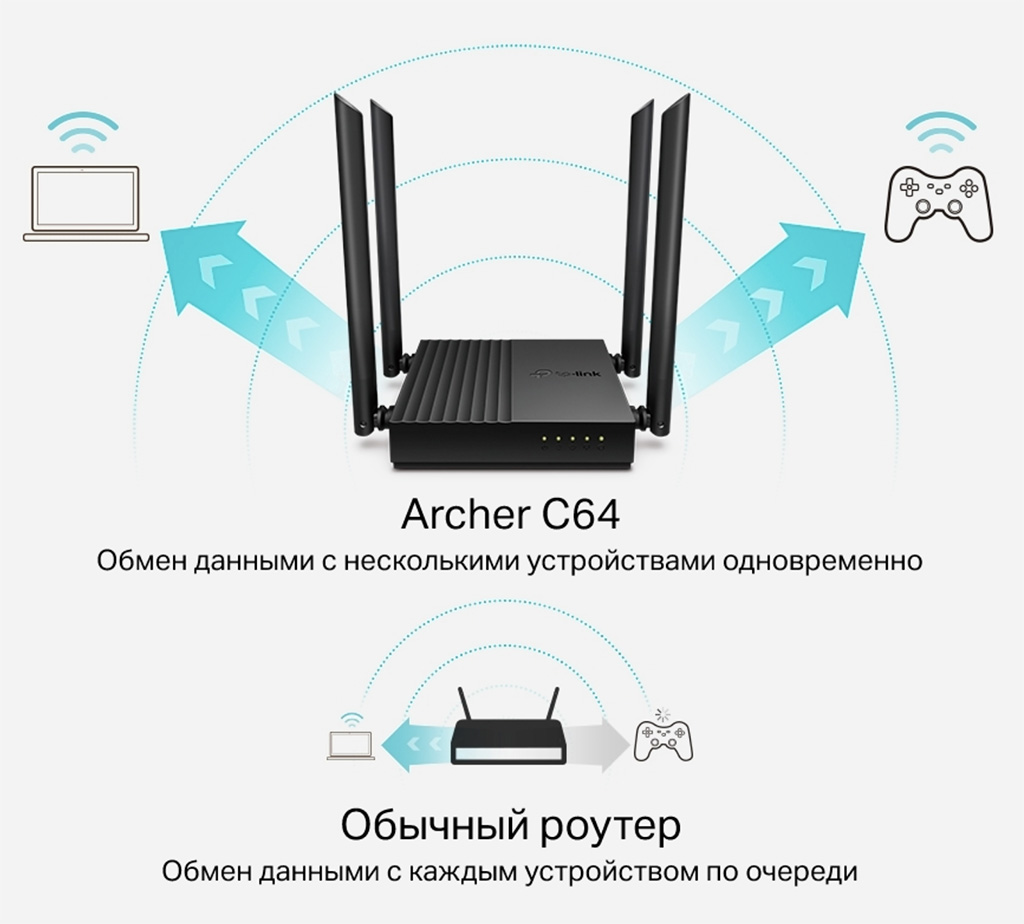
Технология MU-MIMO наглядно.
Другими словами, если к Archer C64 подключатся несколько смартфонов, планшет, умная колонка с голосовым помощником, и все эти устройства одновременно будут соединяться с интернетом, роутер сможет одновременно как принимать от гаджетов информацию, так и транслировать её обратно на устройства.
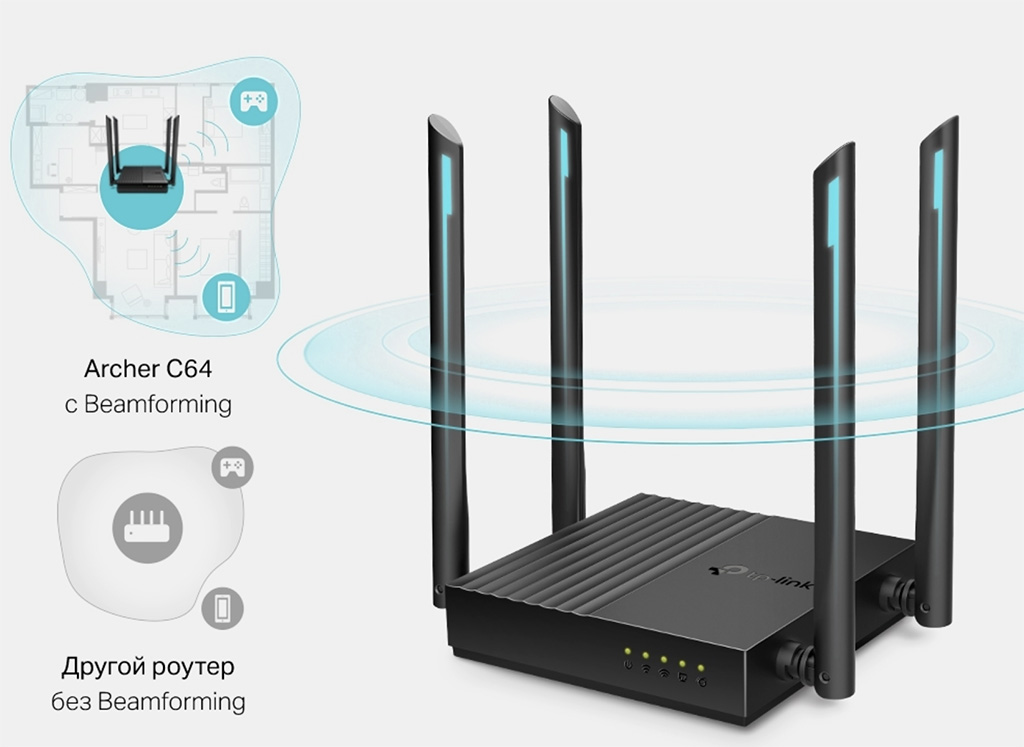
Так работает Beamforming.
То есть, если роутер установлен у меня в коридоре, а я сижу в самой дальней комнате с планшетом и хочу посмотреть свежие ролики в YouTube, роутер автоматически увеличит мощность сигнала в моём направлении, чтобы минимизировать возможные задержки в воспроизведении из-за стен и перекрытий.
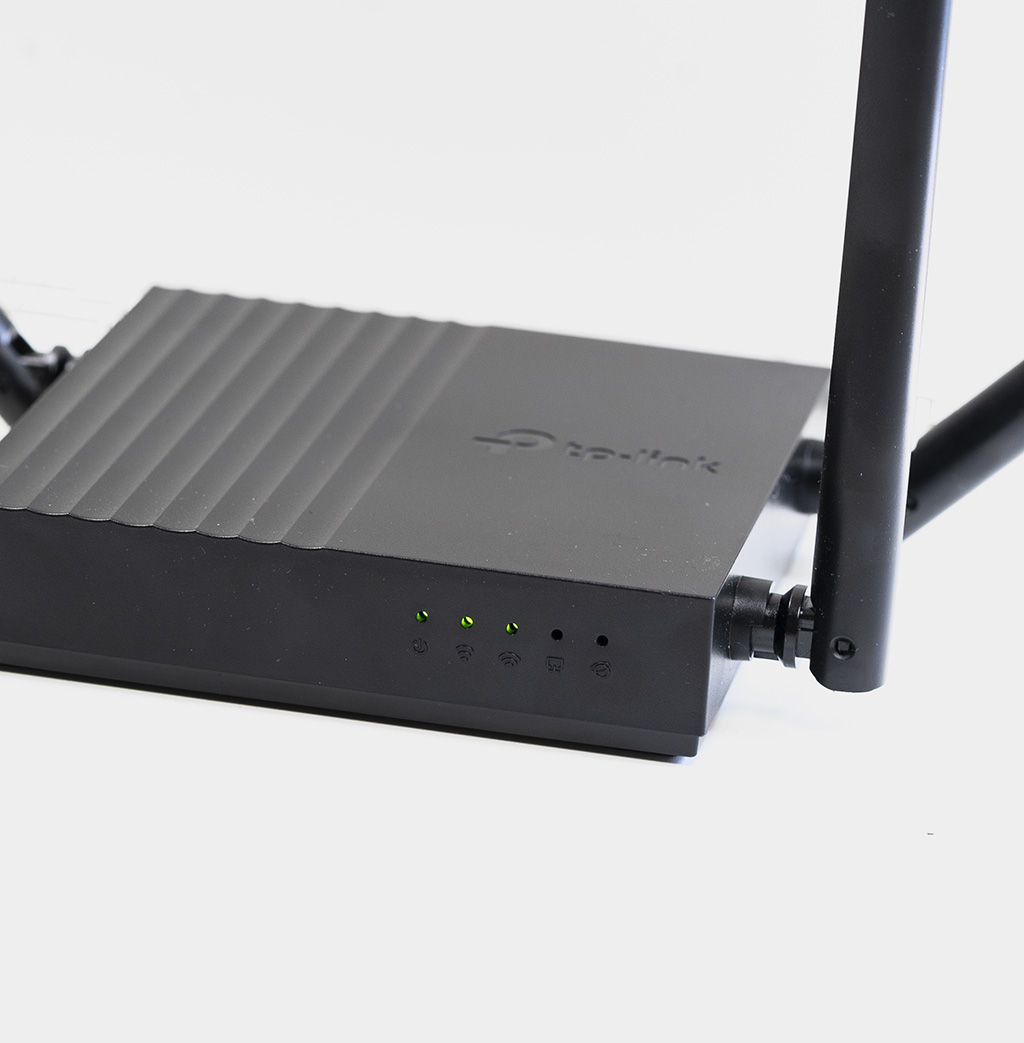
Четыре антенны мощностью 5 дБи каждая, вполне достаточно для квартиры.
К примеру, я вышел в интернет прочитать новый материал на сайте, а девушка рядом открыла планшет, чтобы посмотреть ролики по фотомонтажу. Роутер даст её подключению приоритет и более «жирный» канал, чтобы видео шло без лагов. А мне достанется более медленное соединение, но я этого не замечу, потому что буду просто читать текст.
Таким образом, даже при подключении множества устройств, все они будут пользоваться интернетом без задержек, благодаря грамотному распределению нагрузки.
К примеру, если у меня интернет 300 Мбит/с, а какое-то из моих устройств поддерживает максимальную скорость в 54 Мбит/с, оно не будет замедлять всю сеть.

Четыре высокоскоростных порта хватит для телевизора, ПК и консоли. И ещё один про запас останется.
Стоит добавить, что в роутере, кроме одного гигабитного порта WAN, есть 4 гигабитных порта LAN, к которым обязательно надо подключить игровую консоль, стационарный ПК или смарт-телевизор.
Эти мультимедийные устройства, связанные с интернетом по проводу, а не через Wi-Fi, точно не подведут и не «замрут» в самый ответственный момент: во время онлайн-битвы, просмотра кино или стриминга на тот же Twitch.
Настройка роутера в 4 тапа на смартфоне и ПК
Этот раздел особенно понравится тем, кто не хочет ковыряться в настройках, разбираться с портами, адресами и DNS-записями.
Настройка Archer C64 максимально простая и делается через мобильное приложение TP-Link Tether, которое можно скачать в App Store или Google Play.
❶ После запуска приложения вам нужно будет создать учётную запись, а затем на экране появятся инструкции по настройке.
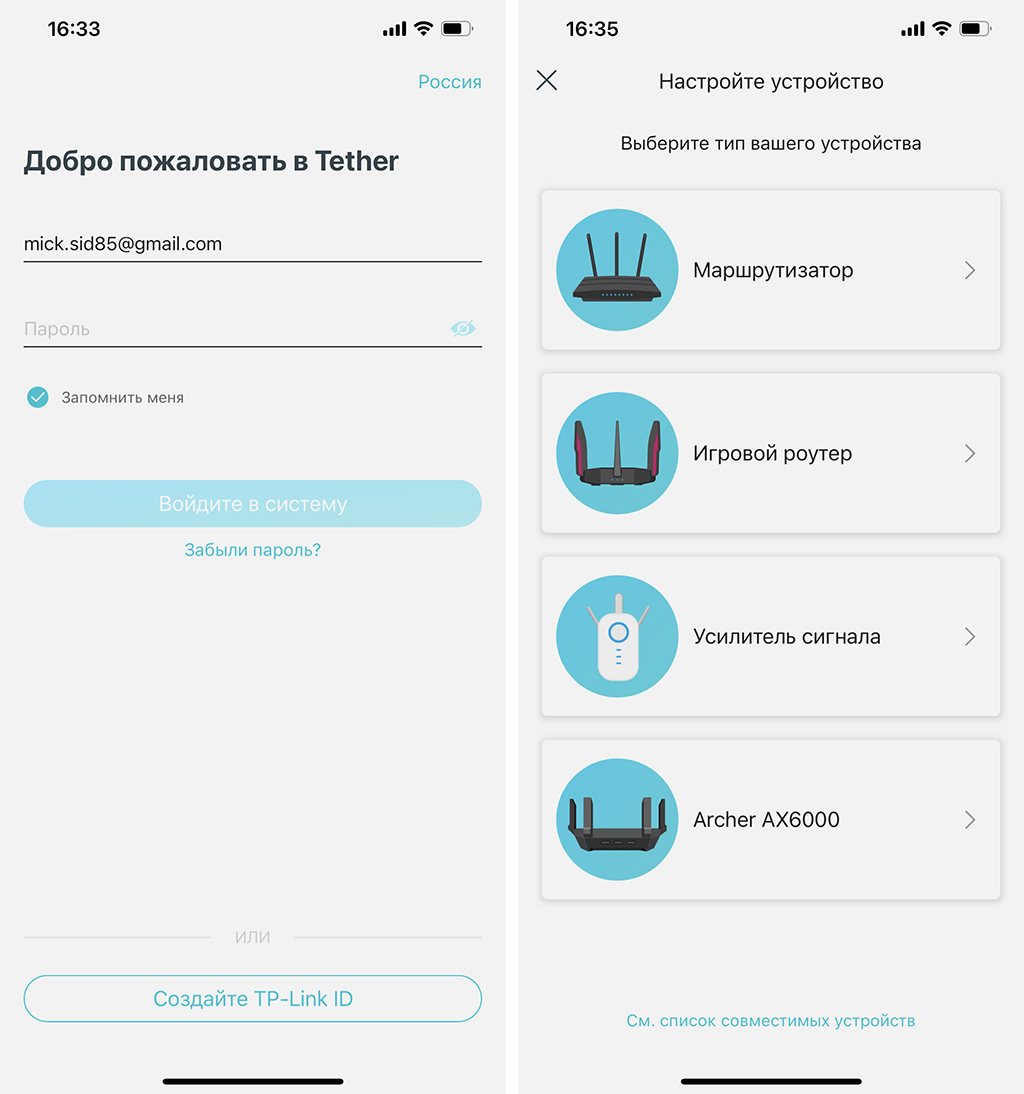
Чтобы найти Archer C64, тапайте на раздел «Маршрутизаторы».
❷ Затем вам будет предложено выйти из приложения и подключиться к дефолтной сети Wi-Fi через настройки смартфона. Имя сети и пароль написаны на нижней части корпуса роутера.
❸ После подключения возвращайтесь в приложение, которое само найдёт работающий роутер и предложит поменять установленный по умолчанию пароль к 2,4 Гц и к 5 Гц сетям.
❹ Первоначальная настройка завершена. Главное, не забудьте воткнуть в соответствующий порт на корпусе роутера заветный интернет-кабель.
Далее в приложении можно смотреть состояние подключения к интернету, сколько устройств и каким образом подключены к роутеру, а также настраивать родительский контроль или вообще, активировать гостевую сеть и урезать в ней вручную скорость до минимума – нечего в гостях в интернете сидеть.
Я настраивал свой интернет именно так, но если вы хотите это сделать через ПК – всё будет так же просто.
Нужно включить роутер в сеть, воткнуть интернет-кабель, а локальным кабелем соединить устройство и ПК.
После подключения кабеля в компьютер, на экране автоматически запустится браузер с окошком входа в настройки нового роутера, а если этого не произошло, откройте браузер и пропишите в адресной строке 192.168.0.1.
Далее нужно будет придумать пароль, указать часовой пояс и придумать названия для сетей Wi-Fi и пароли для них же. Всё.
Я помню, как однажды вручную прописывал параметры настроек в ПО роутера, чтобы интернет заработал, постоянно сверяясь с договором, на котором цифры были написаны от руки и от времени половину невозможно было разобрать. Вот же был хардкор.
Сегодня настроить интернет сможет даже ребёнок.
Тесты и замеры: стабильное соединение в любом углу
У меня двухкомнатная квартира, с небольшим балконом. Роутер я поставил в прихожей, подключил ТВ-приставку и консоль PS4 по проводу, а айфон по Wi-Fi 5 Ггц.
Мой тарифный план – 150 Мбит/с, и с учётом работающего телевизора и обновляющегося Fortnite на «плойке», скорость соединения по Wi-Fi была такая:
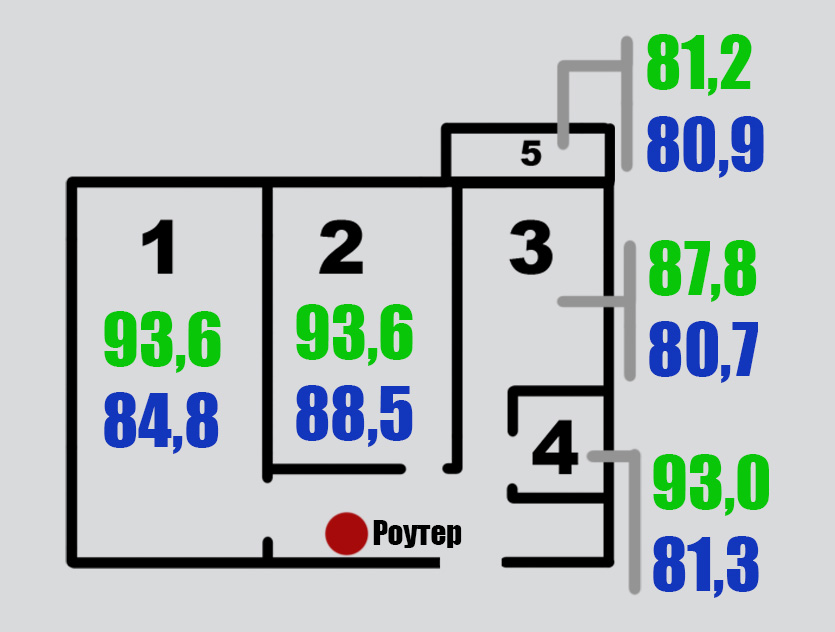
Зелёным я показал скорость закачки, синим – скорость отдачи данных в Мбит/с.
Как видно, достойная связь во всех помещениях, даже на балконе, максимально удалённом от точки доступа. Телевидение не лагает, обновления скачиваются, ютубчик на смартфоне в туалете прекрасно смотрится.
Большего и не надо. Спасибо, TP-Link.
Что в итоге: ни одного разрыва! (с)
В TP-Link Archer C64 нет сложных меню, тонких настроек и прочих, понятных лишь компьютерным гикам, функций. Это устройство для дома, где живёт несколько человек, использующих самые разные гаджеты: от смартфонов до настольных ПК. Кто-то играет в игры, кто-то смотрит видео в туалете, кто-то проверяет почту или подключается по удалённому соединению к компьютеру на работе.
Во всех этих сценариях Archer C64 не подведёт и выдаст максимально доступную скорость соединения, согласно вашему тарифному плану. Этот роутер нужно один раз подключить и забыть на несколько лет: за неделю у меня он не глючил, не перезагружался и не отваливался.
Плюсы Archer C64:
■ стабильное соединение
■ наличие технологий, которые можно найти в более дорогих роутерах
■ есть возможность крепления на стену
■ можно отключить светодиоды на ночь по расписанию
■ можно использовать в режиме дополнительной точки доступа
■ шустрый процессор 1,2 ГГц от MediaTek
Минусы:
Если у вас мега-тариф, в котором скорость интернета выше 1 Гбит – Archer C64 будет не в состоянии выдать максимальную скорость. Но таких тарифных планов очень мало, и если у вас именно такой – скорее всего вы профессиональный геймер или стример, и оборудование у вас уже стоит соответствующее.
В качестве дополнительных достоинств Archer C64 хочется отметить возможность обновления прошивки «по воздуху» и возможность подключения к облачному сервису TP-Link, который позволяет управлять роутером из любой точки мира, видеть состояние подключения, менять настройки, перезагружать и контролировать количество подключённых устройств.
Всем, кому важна стабильность работы домашнего Wi-Fi, я рекомендую обратить внимание на Archer C64. В пределах 2500 рублей лучшего аналога мне найти не удалось.
What is TP-Link EAP/CAP Airtime Fairness?
Why do we need Airtime Fairness?
Traditionally, your phones, laptops, pads or any other devices need to compete for the chance to transmit and receive data when they are connected to the same Wi-Fi signal. In this situation, once a slow transmitting device gets the chance, it will take longer time to send or receive the data. In the meanwhile, other faster devices must wait until the slow device finishes the transmitting process. Based on the above situation, you might want to cut down time given to legacy devices to allow faster devices download data for longer times. This will significantly increase overall capacity of the network. To achieve such objective Airtime Fairness is introduced.
How does Airtime Fairness work?
Airtime Fairness feature is based on TDMA technology, short for Time Division Multiple Access. It divides the Wi-Fi signal into many same time slots, and each Wi-Fi device takes turns to send or receive data from the Internet within its own time slot. In this way, the capacity and efficiency of Wi-Fi will be improved.
As shown above, without Airtime Fairness, those slow clients need more time to transfer the same data, which decreases Wi-Fi efficiency.
With two different speeds of clients connected to the same Wi-Fi, the test result below shows us the improvement of Airtime Fairness. When Airtime Fairness is disabled, the download speed of 802.11g client is 28.075Mbps while 802.11n client is 18.521Mbps. But when Airtime Fairness is enabled, the download speed of 802.11g client is 12.214 while 802.11n client is 116.538Mbps, which is highly improved. The overall throughput of Wi-Fi has tripled (from 46Mbps to 128Mbps).
Which TP-Link products support Airtime Fairness? How to enable this feature?
So far EAP225-Outdoor_V1, EAP320_V1&V2, EAP330_V1&V2 and CAP1200_V1 support Airtime Fairness feature. This feature can be found and enabled in Wireless Advanced settings of the products.
Полезен ли этот FAQ?
Ваши отзывы помогают улучшить этот сайт.
Что вас заинтересовало в этой статье?
Мы хотели бы получить ваши отзывы, пожалуйста, дайте нам знать, как мы можем улучшить этот контент.
Спасибо
Мы ценим ваше мнение.
Нажмите здесь, чтобы связаться со службой технической поддержки TP-Link.
Почему Wi-Fi не будет работать, как планировалось, и зачем знать, каким телефоном пользуется сотрудник
Поговорим о том, что реально влияет на скорость передачи данных в современных беспроводных сетях, развенчаем пару мифов и ответим, пора ли поменять свой старенький роутер на сверкающего рогатого пришельца с MU-MIMO на борту.
Для разминки — небольшая задачка. Представьте себе беспроводную сеть Wi-Fi, состоящую из точки доступа (AP) и двух одинаковых клиентских устройств (STA1 и STA2).
Читаем надписи на коробках:
AP: 1733,3 Мбит/c
STA1, STA2: 866,7 Мбит/c
Внимание, вопрос. Оба клиента одновременно начинают загружать с сервера большой файл. На какую пропускную способность может рассчитывать каждое из устройств?
Сразу оговоримся — для простоты и наглядности мы будем называть пропускную способность (канальную скорость) просто скоростью. Да, скорость работы протоколов транспортного уровня может оказаться в два раза ниже, чем наша скорость, но вы и так всё это знаете. Сейчас о другом.
Наша задачка призвана напомнить о главном ограничении беспроводных сетей.
Общая среда передачи (shared medium) подразумевает, что в единицу времени вещать должно только одно устройство.
Это обстоятельство приводит нас к контринтуитивному ответу: несмотря на то, что точка доступа способна поддерживать 1733,3 Мбит/c, каждое из устройств будет работать, в среднем, на скорости 433,3 Мбит/c.
Куда делись оставшиеся 866,7 Мбит/c? Давайте разбираться.
Для описания принципов работы беспроводных сетей удобно использовать метрику Airtime Utilization. Она показывает, какую часть времени эфир занят передачей данных.
Теперь — внимание! Для того, чтобы развить заявленные 1733,3 Мбит/c, устройство должно единолично занимать эфир все 100% времени. При этом второе устройство (принимающее) должно также поддерживать данную скорость.
Ещё раз подчеркнём — связь между устройствами, поддерживающими разные скорости, осуществляется на скорости наименее быстрого из пары.
Всё становится грустнее, если максимум устройства, например, 72,2 Мбит/c. Занять придётся те же самые 100% эфира, но результат уже совсем не впечатляющий.
К слову, 72,2 Мбит/c — скорость не случайная. Большинство современных смартфонов на большее могут не рассчитывать, но об этом позже.
Теперь вернёмся к STA1 и STA2. По условиям они начали загружать файл на сервер одновременно. Мы помним, что в единицу времени вещать может только одно устройство.
Координирует передачу в сети Wi-Fi механизм CSMA/CA — Carrier Sense Multiple Access with Collision Avoidance. Если вкратце, его задача — последовательно дать право голоса всем устройствам, при этом, по возможности, не допустив одновременной передачи от двух и более устройств (коллизии).
Можете почитать википедию, если хотите подробностей.
А лучше — это. Или — вот, если настроены совсем серьёзно.
Причём тут Airtime Utilization? А при том, что в итоге работы CSMA/CA для данного случая каждое из двух готовых к передаче клиентских устройств получит под свои нужды примерно половину эфирного времени — или 50% Airtime.
100% Airtime — 866,7 Мбит/c;
50% Airtime — 433,3 Мбит/c на каждое из устройств.
Эта картина не поменяется, даже если точка доступа будет поддерживать все 6933,3 Мбит/c. Связь между AP и STA всегда ограничена скоростью наименее быстрого из устройств.
Можете из любопытства слегка поиграться с условиями задачи:
Изменим скорость для STA2 — 72,2 Мбит/c;
Добавим STA3, скорость — 72,2 Мбит/c.
Что осталось от заявленных 1733,3 Мбит/c?
Важное уточнение №1
Справедливости ради добавим, что данные расчёты верны при включении на БС функционала Airtime Fairness, без него всё было бы гораздо хуже — медленные клиентские устройства привели бы к максимально неэффективному распределению Airtime. Хорошо, что технологию внедрили практически все уважающие себя вендоры.
Но и тут есть нюанс: Airtime Fairness работает только в Downlink (от AP к STA). В Uplink по-прежнему царит анархия.
Важное уточнение №2
В реальной сети из-за загруженности эфира, коллизий и особенностей работы протокола максимально достижимый уровень Airtime Utilization находится в пределах от 70% до 80%.
Соответствующим образом поменяется и рассчитанная нами скорость.
К чему столь долгая прелюдия? Знайте, какие клиентские устройства используются на вашей сети. Их влияние на производительность в условиях общей среды передачи данных критически недооценено. Далее будем разбираться — насколько.
Часть 1 — Во всём виноваты клиенты
Или клиентские устройства, если угодно. Чем же они провинились и что, собственно, отличает их от точек доступа?
Всё просто. Чаще всего клиенты — компактные, автономные и мобильные. Из этого вытекают все проблемы.
Стильный металлический корпус толщиной 7 мм? Для размещения 4-х радиотрактов MIMO лучше не придумаешь.
Многопоточная передача данных и широкие каналы слишком энергозатратны? Ничего, пусть заряжают устройства несколько раз в день.
Клиенты постоянно перемещаются? Ерунда — выкрутим мощность на точках на максимум.
В подобных условиях разработчики вынуждены идти на компромиссы.
Помните могучую точку доступа (1733 Мбит/c) из вступления к статье? Давайте пойдём ещё дальше. Стандарт 802.11ac позволяет нам разогнаться до внушительных 6933 Мбит/c.
Условия для этого следующие:
Для наглядности проведём мысленный эксперимент: подключим к нашей абстрактной точке вполне конкретный смартфон — iPhone 8. Посмотрим, на что он способен.
2,4 ГГц vs 5 ГГц
Многолетние наблюдения подтверждают — устройств, работающих в «пятёрке», всё больше. И это прекрасно.
Единственное достоинство 2,4 ГГц — меньшее затухание — на сегодняшний день превратилось едва ли не в недостаток.
При проектировании плотных сетей одна из задач — борьба с интерференцией. Боремся, в том числе, за счёт изоляции зон покрытия AP друг от друга. В ход идут стены, занижается мощность на передатчике, и «дальнобойность» двойки здесь явно лишняя.
Так или иначе — будущее Wi-Fi за «пятёркой», если не рассматривать уж совсем узкие кейсы.
Статистика, тем не менее, не даёт однозначно достоверных данных по распределению устройств — слишком много переменных (страна, регион, локация, мероприятие и другие).
Пожалуй, на сегодняшний день можно осторожно говорить, что в России мы достигли соотношения 50/50 по поддержке в клиентских устройствах диапазона 5 ГГц.
Как будет в вашей сети — другой вопрос.
Наш воображаемый iPhone 8, кстати, «пятёрку» поддерживает, ну и хорошо.
Возможность одновременно передавать несколько потоков данных в едином частотном канале появилась ещё в 802.11n. Однако, воз и ныне там:
SISO (Single Input Single Output) — устройства с одним входным и одним выходным трактами. С них всё начиналось.
MIMO (Multiple Input Multiple Output) — соответственно, множественные входные и выходные каскады. Благодаря MIMO, появилась возможность передавать в одном частотном канале несколько полезных сигналов.
MIMO 4×4:4 значит [4 передающих тракта]x[4 приёмных тракта]:[4 пространственных потока].
MIMO 4×4:3 — бывает.
MIMO 3×3:4 — не бывает.
Точка доступа с MIMO 4×4:4 позволяет, по сути, увеличить скорость передачи данных в 4 раза. Разумеется, если оба устройства (ТД и клиент) обладают равными способностями.
Клиентские устройства с MIMO 4×4:4 начали появляться на рынке совсем недавно. В основном это выделенные адаптеры Wi-Fi, но недавно нас ошарашил Samsung, заявив в описании к своему новому Galaxy Note 9 — MIMO 4×4. Очень некстати, ведь мы хотели написать, что мобильных устройств с подобными характеристиками на рынке пока нет.
В связи с этим — конкурс.
Нам нужен Association Request от Galaxy Note 9 (или любого другого смартфона), подтверждающий поддержку передачи четырёх пространственных потоков. Первый приславший на wireless@comptek.ru PCAP-файл, содержащий указанный фрейм, получит отличный подарок от CompTek.
Важное условие — снять трафик нужно самостоятельно. Можем попросить фото устройства 🙂
Как говорят — исключения подтверждают правило.
Устройств с MIMO 4×4:4 — практически нет. MIMO 3×3:3 — удел редких Macbook Pro. MIMO 2×2:2 — в топовых смартфонах и планшетах. Статистическое большинство — устройства, не поддерживающие MIMO.
Мы не будем как большинство. Наш iPhone 8 — топовый смартфон, поддерживающий передачу аж двух пространственных потоков.
Откуда мы это узнали — важный вопрос. Расскажем в последней части статьи.
Как мы помним, связь между устройствами, поддерживающими разные скорости, осуществляется на скорости наименее быстрого из пары.
Вжух — и осталось 1733,3 Мбит/c. Грустно. Но весело — это ведь почти два гигабита!
Если лень считать — просто воспользуйтесь таблицей.
Ширина канала
802.11ac позволяет нам использовать каналы шириной в 160 МГц.
Пожалуйста, не делайте этого.
Более того, каналы в 80 МГц также категорически не рекомендованы к использованию.
Всё дело в том, что, расширяя полосу, мы, по сути, распахиваем ворота для интерференции всех мастей — портим эфир и себе, и соседям.
Мы не будем подробно разбирать, почему так происходит — это тянет на отдельную статью, однако можете самостоятельно ознакомиться с рекомендациями и Best practice guides ведущих вендоров — только 20 МГц, за редкими исключениями.
40 МГц допускается только в “пятёрке”, в случае, если плотность клиентов и обстановка в эфире позволяет.
Но мы ведь оптимисты — будем считать, что наша сеть именно такая.
Итак, от 1733,3 Мбит/c остаётся 400 Мбит/c — для канал шириной 40 МГц.
С шириной канала немного интереснее. Множители следующие:
×2.1 (40 МГц)
×4.5 (80 МГц)
×9.0 (160 МГц)
За базовую скорость можете взять 96,3 Мбит/c (20 МГц, 1SS, Short Guard interval, 5/6 coding rate).
96.3×9×2 (160 МГц, 2SS)
400
96.3×2.1×2 (40 МГц, 2SS)
Нелинейные коэффициенты — потому что при объединение каналов удаётся задействовать служебные пограничные OFDM-поднесущие.
Жаль, что в реальной сети вреда от широких каналов больше чем пользы.
Не забываем про удобную таблицу.
Ок, уже не так впечатляет, но всё равно неплохо, да?
P.S.: Если вы живёте в лесу и очень хорошо понимаете, что делаете — хорошо, включите 160 МГц. Не факт, что будет толк. Например, пресловутый iPhone 8 такую ширину канала не поддерживает, хотя выпущен всего год назад.
Читайте до конца, чтобы узнать, на что способно ваше устройство.
Модуляция
Любопытный факт: клиентские устройства — основные источники интерференции в сети.
К чему это? А к тому, что даже идеально спланированная и настроенная сеть не гарантирует работу на максимальных модуляциях, ведь 256QAM предъявляет очень высокие требования к качеству сигнала — RSSI и SNR.
Про RSSI мы ещё поговорим, а SNR напрямую страдает от клиентов со всенаправленными антеннами — таких мобильных и непредсказуемых. Ну, и не только от них, разумеется.
Как результат — рассчитывайте, что большую часть времени клиенты будут использовать менее требовательную модуляцию. Например, 64QAM.
В нашем эксперименте это безжалостно снижает скорость до 300 Мбит/c.
Что касается RSSI — то это наш любимый параметр. В стандарте 802.11 никаких описаний и требований к нему нет, поэтому каждый вендор видит данную метрику по-своему. Соответственно, разные клиентские устройства будут показывать разный RSSI в одном и том же месте.
Оказывается, разные устройства одной модели могут по разному оценивать уровень приёма.
Для тех, кто готов во всём идти до конца — пугающий подкаст.
А вот сайт, где можно полюбоваться на собранные по теме данные.
Подытог №1
Даже при весьма оптимистическом сценарии клиент получит всего 300 Мбит/c пропускной способности — вместо 6933 Мбит/c. И это в случае, если клиент всего один! Много таких сетей знаете?
Вспоминаем задачки. Чем больше клиентов — тем хуже. Не хотели расстраивать раньше времени, но зависимость нелинейная. С ростом числа устройств в сети увеличивается процент оверхеда.
Итог: производительность сильно зависит от подключенных клиентов. Скорее всего, их способности будут весьма ограниченными.
Оптимистичный сценарий —300 Мбит/c (5 ГГц, 40 МГц, 2SS, 64QAM).
Реалистичный сценарий — 72 Мбит/c (2,4 или 5 ГГц, 20 МГц, 1SS, 64QAM).
Часть 2 — Что ещё не так с клиентскими устройствами
Да, всё только начинается.
Можно выделить три крупных проблемы:
Многообразие
Помните наш iPhone 8? Хороший телефон, кстати. А знаете, что Apple перестала получать сертификацию Wi-Fi Alliance начиная с iPhone 6?
Можете проверить сами — информация открытая.. Заодно напишите в комментариях о других удивительных открытиях.
Что, собственно, за организация — Wi-Fi Alliance?
Ребята пытаются следить за порядком в зоопарке. Значок Wi-Fi Certified означает, что устройство было проверено на соответствие основным пунктам стандарта 802.11. Проверка ведётся в аккредитованных лабораториях, всё более-менее серьёзно.
Почему возникла подобная необходимость?
Для того, чтобы обеспечить совместимость миллионам разнообразных устройств, работающим на разных чипсетах и разработанных людьми, отличающимися разной степенью квалификации и моральными ориентирами.
Помогло?
Не очень. Как показывает практика, каждый вендор имеет своё уникальное видение и позволяет себе отступать от стандарта (из лучших побуждений, разумеется).
Один из забавных примеров — прошлогодний KRACK. Не все устройства были подвержены уязвимости, так как многие производители по-своему интерпретировали процедуру обмена ключами. В частности — как вести себя в случае отсутствия ответа на третье сообщение последовательности 4-Way Handshake. Почитайте подробнее, если интересно.
Что в итоге?
Зоопарк.
Проще всего, по понятным причинам, с Apple. Хотя они и не сертифицируют свои новинки, парк устройств всё-таки ограничен. Поэтому можно протестировать поведение в тех или иных сценариях.
Дальше идёт Android. Тут многое зависит от производителя, но в целом — ещё больше неизвестных. Добавьте сюда китайцев.
На этом идеи по классификации заканчиваются. Операционные системы, драйвера, legacy-устройства, мультиварки, дверные замки, камеры видеонаблюдения — BYOD и IoT во всей красе.
Проблема усугубляется тем, что многие критические решения клиентские устройства принимают самостоятельно, напрямую повлиять на них нельзя.
Подключиться к «пятёрке» или к «двойке»?
Произвести роуминг или остаться на старой AP?
На какой модуляции работать?
Об этом подробнее в следующей главе.
Непредсказуемость
Wi-Fi устроен так, что клиентские устройства стараются самостоятельно справиться с возникающими трудностями. Не всегда эти решения оптимальны.
Эффективных механизмов, позволяющих прямо управлять поведением клиентских устройств, нет. В этом отличие, например, от сотовой связи.
Вы возразите — а как же 802.11k (Radio resource measurement enchancements) и 802.11v (Wireless network management), принятые в 2008 и 2011 году соответственно?
Данные стандарты теоретически направлены на решение проблемы. Практически — ничего не работает.
Да, точка может отправить Load Balancing Request — вежливо попросить клиента произвести роуминг. Удовлетворять данную просьбу никто не обязан. Более того, клиентов, поддерживающих 802.11k и v, до сих пор мало.
Основное применение описанных выше стандартов — помощь в быстром роуминге механизму 802.11r (Fast BSS transition). Клиент получает список ближайших AP, на которые ему стоило бы переподключиться — и уже дальше сумасбродное устройство решает, что для него лучше.
О роуминг сломано немало копий, хорошие статьи можно найти здесь, на Хабре.
Раз. Два.
Есть ещё монументальное (но незавершённое) исследование прекрасного Andrew von Nagy —
три.
Повторяться не будем, просто ещё раз подчеркнём: переключение между AP — на совести клиента. От этого и большинство проблем.
Вендоры пытаются бороться с самостоятельностью клиентов. Стандартные средства не помогают, поэтому в ход идут ухищрения. Это прямо как в книжках по бизнесу: не пытайся переубедить — сделай так, чтобы клиент сам пришёл к нужному выбору.
Так, например, работает Band Steering (механизм перевода клиентов из «двойки» в более свободную «пятёрку»):
Список можно продолжать бесконечно:
Уязвимость
Как известно, безопасность системы в целом находится на уровне самого слабого из её элементов. В правильно настроенной беспроводной сети таким элементом неизбежно становится клиентское устройство. В чём проблема?
Тема безопасности беспроводных сетей обширна. В данной статье мы ограничимся тем, что основной вектор атаки киберпреступников — так называемый low hanging fruit. Чаще всего таким фруктом становится клиентское устройство.
Зачем пытаться напрямую влезть в защищённую сеть, если достаточно получить доступ к смартфону сотрудника, который из гордости не устанавливает обновления на свою ОС?
Подытог №2
Перечисленные проблемы (многообразие, непредсказуемость и уязвимость клиентских устройств) бросают проектировщикам и администраторам беспроводных сетей серьёзный вызов.
Идеальное планирование, полноценное радиообследование и качественный монтаж не гарантируют стабильную работу сети.
Знать, какими устройствами пользуются абоненты, действительно, важно. Остаётся понять, какими характеристиками обладает то или иное устройство.
Неожиданно — это не самая простая задача.
Часть 3 — Производители что-то скрывают
Способ 1. Логичный
Казалось бы, что может быть проще — заходим на сайт производителя и смотрим на детальные спецификации устройств.
Попробуем на примере привычного iPhone 8:

На сайте Apple.
802.11ac Wi-Fi with MIMO… Не очень-то информативно. Сколько пространственных потоков? Какая максимальная ширина канала? Есть ли поддержка 802.11r, k, v? MU-MIMO?
Samsung делится информацией о своём Galaxy S9 несколько охотнее:

На сайте Samsung.
Даже если отбросить загадочную модуляцию 1024QAM (официально она появится только в 802.11ax), мы по-прежнему знаем об устройстве слишком мало.
Степень открытости производителей варьируется в широких пределах — есть и приятные исключения. В основном же во внутреннюю кухню никого не пускают (снова ради нашей пользы, разумеется), ведь многие знания — многие печали.
С этим согласны не все.
Способ 2. Практичный
Недовольные пользователи уже давно ведут собственные базы, куда заносят добытые характеристики устройств.
Здесь можно найти следующую информацию:
Способ 3. Для гиков
Всё, что нужно — это перехватить обмен сообщениями между абонентом и AP, сопутствующий первоначальному установлению соединения. Данный трафик не шифруется, однако сложности возникнуть могут — не все Wi-Fi адаптеры позволяют «сниффать» 802.11-фреймы. Операционные системы также могут в разной степени облегчить, либо усложнить задачу.
Тема великолепно гуглится, поэтому ссылок давать не будем.
Счастливчики смогут наблюдать следующую картину:
Тут есть всё, друзья.
Из любопытного — тот самый, уже надоевший, iPhone 8 не поддерживает MU-MIMO. Но не будем портить вам удовольствие.
Кстати, готовые PCAP-файлы, полученные пользователями, можно скачать на том же самом clients.mikealbano.com
Способ 4. Бонусный
Есть ещё один замечательный способ узнать всю подноготную устройства. Что примечательно — без регистрации и SMS.
Все продаваемые на территории США устройства обязаны получить сертификацию от FCC — Federal Communications Commission (Федеральная Комиссия по Связи). В результате устройству присваивается FCC ID — уникальный номер, через который можно получить огромный объём информации прямо на сайте FCC.
Сам код (FCC ID) часто можно найти на устройстве, либо на коробке от него. В крайнем случае, поможет интернет.
Код состоит из двух частей: Grantee Code и Product Code. Вводите, как на картинке:
Мы получаем доступ к обширному архиву документов с данными, использованными во время сертификации. Доступны даже внутренние фотографии устройства — в некоторых случаях можно даже разглядеть модели чипов.
Обратите особое внимание на файл SAR Report — на основании данного отчёта можно не только определиться с толщиной шапочки из фольги, но и получить подробную информацию о характеристиках устройства. Бинго!
Подытог №3
Производители не спешат раскрывать полную информацию о характеристиках клиентских устройств. Тем не менее, благодаря активности сообщества, открытым источникам и собственной настойчивости, можно получить все необходимые данные.
Заключение
Зачем же знать, каким телефоном пользуется сотрудник? И пора ли менять свой старенький роутер?
Разумеется, всё зависит от задач. Если вы хотите строить надёжные и предсказуемые сети — отмахнуться от клиентского оборудования не получится. Учитывайте его особенности при планировании и обслуживании — будете вознаграждены снижением расходов и ростом удовлетворённости пользователей.
Всё сказанное не отменяет необходимости в использовании качественных точек доступа: многие наработки ведущих вендоров действительно эффективны — читайте наш блог, чтобы быть в курсе.
И ещё раз — учитывайте характеристики клиентов, чтобы тратить деньги на работающие решения.
Надеемся, что эта статья вам поможет.
Автор: Леонид Теканов, инженер беспроводного отдела CompTek.
Презентация по мотивам статьи прошла 25.10.2018 на нашей ежегодной конференции «БЕСЕДА». Не пропустите следующую.
Полезные ресурсы:
CWNP — если хочется не только хорошо разбираться в беспроводных сетях, но и получить официальное признание в виде сертификата;
Revolution Wi-Fi — сайт Andrew von Nagy — авторитетного товарища, подарившего миру удобнейший Revolution Capacity Planner;
Divergent Dynamics — сайт уважаемого Devin Akin, бескомпромиссного эксперта и автора множества ценных статей;
WLAN Professionals — детище Keith Parsons — настоящего ветерана Wi-Fi. Множество полезных материалов и целая ежегодная конференция для тех, кто настроен серьёзно;
What is TP-Link EAP/CAP Airtime Fairness?
Why do we need Airtime Fairness?
Traditionally, your phones, laptops, pads or any other devices need to compete for the chance to transmit and receive data when they are connected to the same Wi-Fi signal. In this situation, once a slow transmitting device gets the chance, it will take longer time to send or receive the data. In the meanwhile, other faster devices must wait until the slow device finishes the transmitting process. Based on the above situation, you might want to cut down time given to legacy devices to allow faster devices download data for longer times. This will significantly increase overall capacity of the network. To achieve such objective Airtime Fairness is introduced.
How does Airtime Fairness work?
Airtime Fairness feature is based on TDMA technology, short for Time Division Multiple Access. It divides the Wi-Fi signal into many same time slots, and each Wi-Fi device takes turns to send or receive data from the Internet within its own time slot. In this way, the capacity and efficiency of Wi-Fi will be improved.
As shown above, without Airtime Fairness, those slow clients need more time to transfer the same data, which decreases Wi-Fi efficiency.
With two different speeds of clients connected to the same Wi-Fi, the test result below shows us the improvement of Airtime Fairness. When Airtime Fairness is disabled, the download speed of 802.11g client is 28.075Mbps while 802.11n client is 18.521Mbps. But when Airtime Fairness is enabled, the download speed of 802.11g client is 12.214 while 802.11n client is 116.538Mbps, which is highly improved. The overall throughput of Wi-Fi has tripled (from 46Mbps to 128Mbps).
Which TP-Link products support Airtime Fairness? How to enable this feature?
So far EAP225-Outdoor_V1, EAP320_V1&V2, EAP330_V1&V2 and CAP1200_V1 support Airtime Fairness feature. This feature can be found and enabled in Wireless Advanced settings of the products.
Is this faq useful?
Your feedback helps improve this site.
What’s your concern with this article?
We’d love to get your feedback, please let us know how we can improve this content.
Thank you
We appreciate your feedback.
Click here to contact TP-Link technical support.
What is TP-Link EAP/CAP Airtime Fairness?
Why do we need Airtime Fairness?
Traditionally, your phones, laptops, pads or any other devices need to compete for the chance to transmit and receive data when they are connected to the same Wi-Fi signal. In this situation, once a slow transmitting device gets the chance, it will take longer time to send or receive the data. In the meanwhile, other faster devices must wait until the slow device finishes the transmitting process. Based on the above situation, you might want to cut down time given to legacy devices to allow faster devices download data for longer times. This will significantly increase overall capacity of the network. To achieve such objective Airtime Fairness is introduced.
How does Airtime Fairness work?
Airtime Fairness feature is based on TDMA technology, short for Time Division Multiple Access. It divides the Wi-Fi signal into many same time slots, and each Wi-Fi device takes turns to send or receive data from the Internet within its own time slot. In this way, the capacity and efficiency of Wi-Fi will be improved.
As shown above, without Airtime Fairness, those slow clients need more time to transfer the same data, which decreases Wi-Fi efficiency.
With two different speeds of clients connected to the same Wi-Fi, the test result below shows us the improvement of Airtime Fairness. When Airtime Fairness is disabled, the download speed of 802.11g client is 28.075Mbps while 802.11n client is 18.521Mbps. But when Airtime Fairness is enabled, the download speed of 802.11g client is 12.214 while 802.11n client is 116.538Mbps, which is highly improved. The overall throughput of Wi-Fi has tripled (from 46Mbps to 128Mbps).
Which TP-Link products support Airtime Fairness? How to enable this feature?
So far EAP225-Outdoor_V1, EAP320_V1&V2, EAP330_V1&V2 and CAP1200_V1 support Airtime Fairness feature. This feature can be found and enabled in Wireless Advanced settings of the products.
Is this faq useful?
Your feedback helps improve this site.
What’s your concern with this article?
We’d love to get your feedback, please let us know how we can improve this content.
Thank you
We appreciate your feedback.
Click here to contact TP-Link technical support.
What is TP-Link EAP/CAP Airtime Fairness?
Why do we need Airtime Fairness?
Traditionally, your phones, laptops, pads or any other devices need to compete for the chance to transmit and receive data when they are connected to the same Wi-Fi signal. In this situation, once a slow transmitting device gets the chance, it will take longer time to send or receive the data. In the meanwhile, other faster devices must wait until the slow device finishes the transmitting process. Based on the above situation, you might want to cut down time given to legacy devices to allow faster devices download data for longer times. This will significantly increase overall capacity of the network. To achieve such objective Airtime Fairness is introduced.
How does Airtime Fairness work?
Airtime Fairness feature is based on TDMA technology, short for Time Division Multiple Access. It divides the Wi-Fi signal into many same time slots, and each Wi-Fi device takes turns to send or receive data from the Internet within its own time slot. In this way, the capacity and efficiency of Wi-Fi will be improved.
As shown above, without Airtime Fairness, those slow clients need more time to transfer the same data, which decreases Wi-Fi efficiency.
With two different speeds of clients connected to the same Wi-Fi, the test result below shows us the improvement of Airtime Fairness. When Airtime Fairness is disabled, the download speed of 802.11g client is 28.075Mbps while 802.11n client is 18.521Mbps. But when Airtime Fairness is enabled, the download speed of 802.11g client is 12.214 while 802.11n client is 116.538Mbps, which is highly improved. The overall throughput of Wi-Fi has tripled (from 46Mbps to 128Mbps).
Which TP-Link products support Airtime Fairness? How to enable this feature?
So far EAP225-Outdoor_V1, EAP320_V1&V2, EAP330_V1&V2 and CAP1200_V1 support Airtime Fairness feature. This feature can be found and enabled in Wireless Advanced settings of the products.
Is this faq useful?
Your feedback helps improve this site.
What’s your concern with this article?
We’d love to get your feedback, please let us know how we can improve this content.
Thank you
We appreciate your feedback.
Click here to contact TP-Link technical support.
What is TP-Link EAP/CAP Airtime Fairness?
Why do we need Airtime Fairness?
Traditionally, your phones, laptops, pads or any other devices need to compete for the chance to transmit and receive data when they are connected to the same Wi-Fi signal. In this situation, once a slow transmitting device gets the chance, it will take longer time to send or receive the data. In the meanwhile, other faster devices must wait until the slow device finishes the transmitting process. Based on the above situation, you might want to cut down time given to legacy devices to allow faster devices download data for longer times. This will significantly increase overall capacity of the network. To achieve such objective Airtime Fairness is introduced.
How does Airtime Fairness work?
Airtime Fairness feature is based on TDMA technology, short for Time Division Multiple Access. It divides the Wi-Fi signal into many same time slots, and each Wi-Fi device takes turns to send or receive data from the Internet within its own time slot. In this way, the capacity and efficiency of Wi-Fi will be improved.
As shown above, without Airtime Fairness, those slow clients need more time to transfer the same data, which decreases Wi-Fi efficiency.
With two different speeds of clients connected to the same Wi-Fi, the test result below shows us the improvement of Airtime Fairness. When Airtime Fairness is disabled, the download speed of 802.11g client is 28.075Mbps while 802.11n client is 18.521Mbps. But when Airtime Fairness is enabled, the download speed of 802.11g client is 12.214 while 802.11n client is 116.538Mbps, which is highly improved. The overall throughput of Wi-Fi has tripled (from 46Mbps to 128Mbps).
Which TP-Link products support Airtime Fairness? How to enable this feature?
So far EAP225-Outdoor_V1, EAP320_V1&V2, EAP330_V1&V2 and CAP1200_V1 support Airtime Fairness feature. This feature can be found and enabled in Wireless Advanced settings of the products.
هل تجد هذه الأسئلة مفيدة؟
مشاركتك تساعدنا في تحسين الموقع
ما الأمر الذي لا يرضيك حول هذا المقال؟
يسعدنا تلقي تعليقاتك، يرجى إعلامنا بكيفية تحسين هذا المحتوى.
شكرًا لك
نحن نقدر ملاحظاتك.
انقر هنا للاتصال بالدعم الفني لـ TP-Link.
What is TP-Link EAP/CAP Airtime Fairness?
Why do we need Airtime Fairness?
Traditionally, your phones, laptops, pads or any other devices need to compete for the chance to transmit and receive data when they are connected to the same Wi-Fi signal. In this situation, once a slow transmitting device gets the chance, it will take longer time to send or receive the data. In the meanwhile, other faster devices must wait until the slow device finishes the transmitting process. Based on the above situation, you might want to cut down time given to legacy devices to allow faster devices download data for longer times. This will significantly increase overall capacity of the network. To achieve such objective Airtime Fairness is introduced.
How does Airtime Fairness work?
Airtime Fairness feature is based on TDMA technology, short for Time Division Multiple Access. It divides the Wi-Fi signal into many same time slots, and each Wi-Fi device takes turns to send or receive data from the Internet within its own time slot. In this way, the capacity and efficiency of Wi-Fi will be improved.
As shown above, without Airtime Fairness, those slow clients need more time to transfer the same data, which decreases Wi-Fi efficiency.
With two different speeds of clients connected to the same Wi-Fi, the test result below shows us the improvement of Airtime Fairness. When Airtime Fairness is disabled, the download speed of 802.11g client is 28.075Mbps while 802.11n client is 18.521Mbps. But when Airtime Fairness is enabled, the download speed of 802.11g client is 12.214 while 802.11n client is 116.538Mbps, which is highly improved. The overall throughput of Wi-Fi has tripled (from 46Mbps to 128Mbps).
Which TP-Link products support Airtime Fairness? How to enable this feature?
So far EAP225-Outdoor_V1, EAP320_V1&V2, EAP330_V1&V2 and CAP1200_V1 support Airtime Fairness feature. This feature can be found and enabled in Wireless Advanced settings of the products.
Is this faq useful?
Your feedback helps improve this site.
What’s your concern with this article?
We’d love to get your feedback, please let us know how we can improve this content.
Thank you
We appreciate your feedback.
Click here to contact TP-Link technical support.
What is TP-Link EAP/CAP Airtime Fairness?
Why do we need Airtime Fairness?
Traditionally, your phones, laptops, pads or any other devices need to compete for the chance to transmit and receive data when they are connected to the same Wi-Fi signal. In this situation, once a slow transmitting device gets the chance, it will take longer time to send or receive the data. In the meanwhile, other faster devices must wait until the slow device finishes the transmitting process. Based on the above situation, you might want to cut down time given to legacy devices to allow faster devices download data for longer times. This will significantly increase overall capacity of the network. To achieve such objective Airtime Fairness is introduced.
How does Airtime Fairness work?
Airtime Fairness feature is based on TDMA technology, short for Time Division Multiple Access. It divides the Wi-Fi signal into many same time slots, and each Wi-Fi device takes turns to send or receive data from the Internet within its own time slot. In this way, the capacity and efficiency of Wi-Fi will be improved.
As shown above, without Airtime Fairness, those slow clients need more time to transfer the same data, which decreases Wi-Fi efficiency.
With two different speeds of clients connected to the same Wi-Fi, the test result below shows us the improvement of Airtime Fairness. When Airtime Fairness is disabled, the download speed of 802.11g client is 28.075Mbps while 802.11n client is 18.521Mbps. But when Airtime Fairness is enabled, the download speed of 802.11g client is 12.214 while 802.11n client is 116.538Mbps, which is highly improved. The overall throughput of Wi-Fi has tripled (from 46Mbps to 128Mbps).
Which TP-Link products support Airtime Fairness? How to enable this feature?
So far EAP225-Outdoor_V1, EAP320_V1&V2, EAP330_V1&V2 and CAP1200_V1 support Airtime Fairness feature. This feature can be found and enabled in Wireless Advanced settings of the products.
Is this faq useful?
Your feedback helps improve this site.
What’s your concern with this article?
We’d love to get your feedback, please let us know how we can improve this content.
Thank you
We appreciate your feedback.
Click here to contact TP-Link technical support.
What is TP-Link EAP/CAP Airtime Fairness?
Why do we need Airtime Fairness?
Traditionally, your phones, laptops, pads or any other devices need to compete for the chance to transmit and receive data when they are connected to the same Wi-Fi signal. In this situation, once a slow transmitting device gets the chance, it will take longer time to send or receive the data. In the meanwhile, other faster devices must wait until the slow device finishes the transmitting process. Based on the above situation, you might want to cut down time given to legacy devices to allow faster devices download data for longer times. This will significantly increase overall capacity of the network. To achieve such objective Airtime Fairness is introduced.
How does Airtime Fairness work?
Airtime Fairness feature is based on TDMA technology, short for Time Division Multiple Access. It divides the Wi-Fi signal into many same time slots, and each Wi-Fi device takes turns to send or receive data from the Internet within its own time slot. In this way, the capacity and efficiency of Wi-Fi will be improved.
As shown above, without Airtime Fairness, those slow clients need more time to transfer the same data, which decreases Wi-Fi efficiency.
With two different speeds of clients connected to the same Wi-Fi, the test result below shows us the improvement of Airtime Fairness. When Airtime Fairness is disabled, the download speed of 802.11g client is 28.075Mbps while 802.11n client is 18.521Mbps. But when Airtime Fairness is enabled, the download speed of 802.11g client is 12.214 while 802.11n client is 116.538Mbps, which is highly improved. The overall throughput of Wi-Fi has tripled (from 46Mbps to 128Mbps).
Which TP-Link products support Airtime Fairness? How to enable this feature?
So far EAP225-Outdoor_V1, EAP320_V1&V2, EAP330_V1&V2 and CAP1200_V1 support Airtime Fairness feature. This feature can be found and enabled in Wireless Advanced settings of the products.
Is this faq useful?
Your feedback helps improve this site.
What’s your concern with this article?
We’d love to get your feedback, please let us know how we can improve this content.
Thank you
We appreciate your feedback.
Click here to contact TP-Link technical support.
What is TP-Link EAP/CAP Airtime Fairness?
Why do we need Airtime Fairness?
Traditionally, your phones, laptops, pads or any other devices need to compete for the chance to transmit and receive data when they are connected to the same Wi-Fi signal. In this situation, once a slow transmitting device gets the chance, it will take longer time to send or receive the data. In the meanwhile, other faster devices must wait until the slow device finishes the transmitting process. Based on the above situation, you might want to cut down time given to legacy devices to allow faster devices download data for longer times. This will significantly increase overall capacity of the network. To achieve such objective Airtime Fairness is introduced.
How does Airtime Fairness work?
Airtime Fairness feature is based on TDMA technology, short for Time Division Multiple Access. It divides the Wi-Fi signal into many same time slots, and each Wi-Fi device takes turns to send or receive data from the Internet within its own time slot. In this way, the capacity and efficiency of Wi-Fi will be improved.
As shown above, without Airtime Fairness, those slow clients need more time to transfer the same data, which decreases Wi-Fi efficiency.
With two different speeds of clients connected to the same Wi-Fi, the test result below shows us the improvement of Airtime Fairness. When Airtime Fairness is disabled, the download speed of 802.11g client is 28.075Mbps while 802.11n client is 18.521Mbps. But when Airtime Fairness is enabled, the download speed of 802.11g client is 12.214 while 802.11n client is 116.538Mbps, which is highly improved. The overall throughput of Wi-Fi has tripled (from 46Mbps to 128Mbps).
Which TP-Link products support Airtime Fairness? How to enable this feature?
So far EAP225-Outdoor_V1, EAP320_V1&V2, EAP330_V1&V2 and CAP1200_V1 support Airtime Fairness feature. This feature can be found and enabled in Wireless Advanced settings of the products.
Is this faq useful?
Your feedback helps improve this site.
What’s your concern with this article?
We’d love to get your feedback, please let us know how we can improve this content.
Thank you
We appreciate your feedback.
Click here to contact TP-Link technical support.
What is TP-Link EAP/CAP Airtime Fairness?
Why do we need Airtime Fairness?
Traditionally, your phones, laptops, pads or any other devices need to compete for the chance to transmit and receive data when they are connected to the same Wi-Fi signal. In this situation, once a slow transmitting device gets the chance, it will take longer time to send or receive the data. In the meanwhile, other faster devices must wait until the slow device finishes the transmitting process. Based on the above situation, you might want to cut down time given to legacy devices to allow faster devices download data for longer times. This will significantly increase overall capacity of the network. To achieve such objective Airtime Fairness is introduced.
How does Airtime Fairness work?
Airtime Fairness feature is based on TDMA technology, short for Time Division Multiple Access. It divides the Wi-Fi signal into many same time slots, and each Wi-Fi device takes turns to send or receive data from the Internet within its own time slot. In this way, the capacity and efficiency of Wi-Fi will be improved.
As shown above, without Airtime Fairness, those slow clients need more time to transfer the same data, which decreases Wi-Fi efficiency.
With two different speeds of clients connected to the same Wi-Fi, the test result below shows us the improvement of Airtime Fairness. When Airtime Fairness is disabled, the download speed of 802.11g client is 28.075Mbps while 802.11n client is 18.521Mbps. But when Airtime Fairness is enabled, the download speed of 802.11g client is 12.214 while 802.11n client is 116.538Mbps, which is highly improved. The overall throughput of Wi-Fi has tripled (from 46Mbps to 128Mbps).
Which TP-Link products support Airtime Fairness? How to enable this feature?
So far EAP225-Outdoor_V1, EAP320_V1&V2, EAP330_V1&V2 and CAP1200_V1 support Airtime Fairness feature. This feature can be found and enabled in Wireless Advanced settings of the products.
Is this faq useful?
Your feedback helps improve this site.
What’s your concern with this article?
We’d love to get your feedback, please let us know how we can improve this content.
Thank you
We appreciate your feedback.
Click here to contact TP-Link technical support.
What is TP-Link EAP/CAP Airtime Fairness?
Why do we need Airtime Fairness?
Traditionally, your phones, laptops, pads or any other devices need to compete for the chance to transmit and receive data when they are connected to the same Wi-Fi signal. In this situation, once a slow transmitting device gets the chance, it will take longer time to send or receive the data. In the meanwhile, other faster devices must wait until the slow device finishes the transmitting process. Based on the above situation, you might want to cut down time given to legacy devices to allow faster devices download data for longer times. This will significantly increase overall capacity of the network. To achieve such objective Airtime Fairness is introduced.
How does Airtime Fairness work?
Airtime Fairness feature is based on TDMA technology, short for Time Division Multiple Access. It divides the Wi-Fi signal into many same time slots, and each Wi-Fi device takes turns to send or receive data from the Internet within its own time slot. In this way, the capacity and efficiency of Wi-Fi will be improved.
As shown above, without Airtime Fairness, those slow clients need more time to transfer the same data, which decreases Wi-Fi efficiency.
With two different speeds of clients connected to the same Wi-Fi, the test result below shows us the improvement of Airtime Fairness. When Airtime Fairness is disabled, the download speed of 802.11g client is 28.075Mbps while 802.11n client is 18.521Mbps. But when Airtime Fairness is enabled, the download speed of 802.11g client is 12.214 while 802.11n client is 116.538Mbps, which is highly improved. The overall throughput of Wi-Fi has tripled (from 46Mbps to 128Mbps).
Which TP-Link products support Airtime Fairness? How to enable this feature?
So far EAP225-Outdoor_V1, EAP320_V1&V2, EAP330_V1&V2 and CAP1200_V1 support Airtime Fairness feature. This feature can be found and enabled in Wireless Advanced settings of the products.
Is this faq useful?
Your feedback helps improve this site.
What’s your concern with this article?
We’d love to get your feedback, please let us know how we can improve this content.
Thank you
We appreciate your feedback.
Click here to contact TP-Link technical support.
What is TP-Link EAP/CAP Airtime Fairness?
Why do we need Airtime Fairness?
Traditionally, your phones, laptops, pads or any other devices need to compete for the chance to transmit and receive data when they are connected to the same Wi-Fi signal. In this situation, once a slow transmitting device gets the chance, it will take longer time to send or receive the data. In the meanwhile, other faster devices must wait until the slow device finishes the transmitting process. Based on the above situation, you might want to cut down time given to legacy devices to allow faster devices download data for longer times. This will significantly increase overall capacity of the network. To achieve such objective Airtime Fairness is introduced.
How does Airtime Fairness work?
Airtime Fairness feature is based on TDMA technology, short for Time Division Multiple Access. It divides the Wi-Fi signal into many same time slots, and each Wi-Fi device takes turns to send or receive data from the Internet within its own time slot. In this way, the capacity and efficiency of Wi-Fi will be improved.
As shown above, without Airtime Fairness, those slow clients need more time to transfer the same data, which decreases Wi-Fi efficiency.
With two different speeds of clients connected to the same Wi-Fi, the test result below shows us the improvement of Airtime Fairness. When Airtime Fairness is disabled, the download speed of 802.11g client is 28.075Mbps while 802.11n client is 18.521Mbps. But when Airtime Fairness is enabled, the download speed of 802.11g client is 12.214 while 802.11n client is 116.538Mbps, which is highly improved. The overall throughput of Wi-Fi has tripled (from 46Mbps to 128Mbps).
Which TP-Link products support Airtime Fairness? How to enable this feature?
So far EAP225-Outdoor_V1, EAP320_V1&V2, EAP330_V1&V2 and CAP1200_V1 support Airtime Fairness feature. This feature can be found and enabled in Wireless Advanced settings of the products.
Is this faq useful?
Your feedback helps improve this site.
What’s your concern with this article?
We’d love to get your feedback, please let us know how we can improve this content.
Thank you
We appreciate your feedback.
Click here to contact TP-Link technical support.
What is TP-Link EAP/CAP Airtime Fairness?
Why do we need Airtime Fairness?
Traditionally, your phones, laptops, pads or any other devices need to compete for the chance to transmit and receive data when they are connected to the same Wi-Fi signal. In this situation, once a slow transmitting device gets the chance, it will take longer time to send or receive the data. In the meanwhile, other faster devices must wait until the slow device finishes the transmitting process. Based on the above situation, you might want to cut down time given to legacy devices to allow faster devices download data for longer times. This will significantly increase overall capacity of the network. To achieve such objective Airtime Fairness is introduced.
How does Airtime Fairness work?
Airtime Fairness feature is based on TDMA technology, short for Time Division Multiple Access. It divides the Wi-Fi signal into many same time slots, and each Wi-Fi device takes turns to send or receive data from the Internet within its own time slot. In this way, the capacity and efficiency of Wi-Fi will be improved.
As shown above, without Airtime Fairness, those slow clients need more time to transfer the same data, which decreases Wi-Fi efficiency.
With two different speeds of clients connected to the same Wi-Fi, the test result below shows us the improvement of Airtime Fairness. When Airtime Fairness is disabled, the download speed of 802.11g client is 28.075Mbps while 802.11n client is 18.521Mbps. But when Airtime Fairness is enabled, the download speed of 802.11g client is 12.214 while 802.11n client is 116.538Mbps, which is highly improved. The overall throughput of Wi-Fi has tripled (from 46Mbps to 128Mbps).
Which TP-Link products support Airtime Fairness? How to enable this feature?
So far EAP225-Outdoor_V1, EAP320_V1&V2, EAP330_V1&V2 and CAP1200_V1 support Airtime Fairness feature. This feature can be found and enabled in Wireless Advanced settings of the products.
Is this faq useful?
Your feedback helps improve this site.
What’s your concern with this article?
We’d love to get your feedback, please let us know how we can improve this content.
Thank you
We appreciate your feedback.
Click here to contact TP-Link technical support.
What is TP-Link EAP/CAP Airtime Fairness?
Why do we need Airtime Fairness?
Traditionally, your phones, laptops, pads or any other devices need to compete for the chance to transmit and receive data when they are connected to the same Wi-Fi signal. In this situation, once a slow transmitting device gets the chance, it will take longer time to send or receive the data. In the meanwhile, other faster devices must wait until the slow device finishes the transmitting process. Based on the above situation, you might want to cut down time given to legacy devices to allow faster devices download data for longer times. This will significantly increase overall capacity of the network. To achieve such objective Airtime Fairness is introduced.
How does Airtime Fairness work?
Airtime Fairness feature is based on TDMA technology, short for Time Division Multiple Access. It divides the Wi-Fi signal into many same time slots, and each Wi-Fi device takes turns to send or receive data from the Internet within its own time slot. In this way, the capacity and efficiency of Wi-Fi will be improved.
As shown above, without Airtime Fairness, those slow clients need more time to transfer the same data, which decreases Wi-Fi efficiency.
With two different speeds of clients connected to the same Wi-Fi, the test result below shows us the improvement of Airtime Fairness. When Airtime Fairness is disabled, the download speed of 802.11g client is 28.075Mbps while 802.11n client is 18.521Mbps. But when Airtime Fairness is enabled, the download speed of 802.11g client is 12.214 while 802.11n client is 116.538Mbps, which is highly improved. The overall throughput of Wi-Fi has tripled (from 46Mbps to 128Mbps).
Which TP-Link products support Airtime Fairness? How to enable this feature?
So far EAP225-Outdoor_V1, EAP320_V1&V2, EAP330_V1&V2 and CAP1200_V1 support Airtime Fairness feature. This feature can be found and enabled in Wireless Advanced settings of the products.
Is this faq useful?
Your feedback helps improve this site.
What’s your concern with this article?
We’d love to get your feedback, please let us know how we can improve this content.
Thank you
We appreciate your feedback.
Click here to contact TP-Link technical support.
What is TP-Link EAP/CAP Airtime Fairness?
Why do we need Airtime Fairness?
Traditionally, your phones, laptops, pads or any other devices need to compete for the chance to transmit and receive data when they are connected to the same Wi-Fi signal. In this situation, once a slow transmitting device gets the chance, it will take longer time to send or receive the data. In the meanwhile, other faster devices must wait until the slow device finishes the transmitting process. Based on the above situation, you might want to cut down time given to legacy devices to allow faster devices download data for longer times. This will significantly increase overall capacity of the network. To achieve such objective Airtime Fairness is introduced.
How does Airtime Fairness work?
Airtime Fairness feature is based on TDMA technology, short for Time Division Multiple Access. It divides the Wi-Fi signal into many same time slots, and each Wi-Fi device takes turns to send or receive data from the Internet within its own time slot. In this way, the capacity and efficiency of Wi-Fi will be improved.
As shown above, without Airtime Fairness, those slow clients need more time to transfer the same data, which decreases Wi-Fi efficiency.
With two different speeds of clients connected to the same Wi-Fi, the test result below shows us the improvement of Airtime Fairness. When Airtime Fairness is disabled, the download speed of 802.11g client is 28.075Mbps while 802.11n client is 18.521Mbps. But when Airtime Fairness is enabled, the download speed of 802.11g client is 12.214 while 802.11n client is 116.538Mbps, which is highly improved. The overall throughput of Wi-Fi has tripled (from 46Mbps to 128Mbps).
Which TP-Link products support Airtime Fairness? How to enable this feature?
So far EAP225-Outdoor_V1, EAP320_V1&V2, EAP330_V1&V2 and CAP1200_V1 support Airtime Fairness feature. This feature can be found and enabled in Wireless Advanced settings of the products.
Is this faq useful?
Your feedback helps improve this site.
What’s your concern with this article?
We’d love to get your feedback, please let us know how we can improve this content.
Thank you
We appreciate your feedback.
Click here to contact TP-Link technical support.
What is TP-Link EAP/CAP Airtime Fairness?
Why do we need Airtime Fairness?
Traditionally, your phones, laptops, pads or any other devices need to compete for the chance to transmit and receive data when they are connected to the same Wi-Fi signal. In this situation, once a slow transmitting device gets the chance, it will take longer time to send or receive the data. In the meanwhile, other faster devices must wait until the slow device finishes the transmitting process. Based on the above situation, you might want to cut down time given to legacy devices to allow faster devices download data for longer times. This will significantly increase overall capacity of the network. To achieve such objective Airtime Fairness is introduced.
How does Airtime Fairness work?
Airtime Fairness feature is based on TDMA technology, short for Time Division Multiple Access. It divides the Wi-Fi signal into many same time slots, and each Wi-Fi device takes turns to send or receive data from the Internet within its own time slot. In this way, the capacity and efficiency of Wi-Fi will be improved.
As shown above, without Airtime Fairness, those slow clients need more time to transfer the same data, which decreases Wi-Fi efficiency.
With two different speeds of clients connected to the same Wi-Fi, the test result below shows us the improvement of Airtime Fairness. When Airtime Fairness is disabled, the download speed of 802.11g client is 28.075Mbps while 802.11n client is 18.521Mbps. But when Airtime Fairness is enabled, the download speed of 802.11g client is 12.214 while 802.11n client is 116.538Mbps, which is highly improved. The overall throughput of Wi-Fi has tripled (from 46Mbps to 128Mbps).
Which TP-Link products support Airtime Fairness? How to enable this feature?
So far EAP225-Outdoor_V1, EAP320_V1&V2, EAP330_V1&V2 and CAP1200_V1 support Airtime Fairness feature. This feature can be found and enabled in Wireless Advanced settings of the products.
Is this faq useful?
Your feedback helps improve this site.
What’s your concern with this article?
We’d love to get your feedback, please let us know how we can improve this content.
Thank you
We appreciate your feedback.
Click here to contact TP-Link technical support.
What is TP-Link EAP/CAP Airtime Fairness?
Why do we need Airtime Fairness?
Traditionally, your phones, laptops, pads or any other devices need to compete for the chance to transmit and receive data when they are connected to the same Wi-Fi signal. In this situation, once a slow transmitting device gets the chance, it will take longer time to send or receive the data. In the meanwhile, other faster devices must wait until the slow device finishes the transmitting process. Based on the above situation, you might want to cut down time given to legacy devices to allow faster devices download data for longer times. This will significantly increase overall capacity of the network. To achieve such objective Airtime Fairness is introduced.
How does Airtime Fairness work?
Airtime Fairness feature is based on TDMA technology, short for Time Division Multiple Access. It divides the Wi-Fi signal into many same time slots, and each Wi-Fi device takes turns to send or receive data from the Internet within its own time slot. In this way, the capacity and efficiency of Wi-Fi will be improved.
As shown above, without Airtime Fairness, those slow clients need more time to transfer the same data, which decreases Wi-Fi efficiency.
With two different speeds of clients connected to the same Wi-Fi, the test result below shows us the improvement of Airtime Fairness. When Airtime Fairness is disabled, the download speed of 802.11g client is 28.075Mbps while 802.11n client is 18.521Mbps. But when Airtime Fairness is enabled, the download speed of 802.11g client is 12.214 while 802.11n client is 116.538Mbps, which is highly improved. The overall throughput of Wi-Fi has tripled (from 46Mbps to 128Mbps).
Which TP-Link products support Airtime Fairness? How to enable this feature?
So far EAP225-Outdoor_V1, EAP320_V1&V2, EAP330_V1&V2 and CAP1200_V1 support Airtime Fairness feature. This feature can be found and enabled in Wireless Advanced settings of the products.
Is this faq useful?
Your feedback helps improve this site.
What’s your concern with this article?
We’d love to get your feedback, please let us know how we can improve this content.
Thank you
We appreciate your feedback.
Click here to contact TP-Link technical support.
Recommend Products
AC1750 Wireless MU-MIMO Gigabit Ceiling Mount Access Point
Omada AC1200 Wireless MU-MIMO Gigabit Wall Plate Access Point
300Mbps Wireless N Ceiling Mount Access Point
What is TP-Link EAP/CAP Airtime Fairness?
Why do we need Airtime Fairness?
Traditionally, your phones, laptops, pads or any other devices need to compete for the chance to transmit and receive data when they are connected to the same Wi-Fi signal. In this situation, once a slow transmitting device gets the chance, it will take longer time to send or receive the data. In the meanwhile, other faster devices must wait until the slow device finishes the transmitting process. Based on the above situation, you might want to cut down time given to legacy devices to allow faster devices download data for longer times. This will significantly increase overall capacity of the network. To achieve such objective Airtime Fairness is introduced.
How does Airtime Fairness work?
Airtime Fairness feature is based on TDMA technology, short for Time Division Multiple Access. It divides the Wi-Fi signal into many same time slots, and each Wi-Fi device takes turns to send or receive data from the Internet within its own time slot. In this way, the capacity and efficiency of Wi-Fi will be improved.
As shown above, without Airtime Fairness, those slow clients need more time to transfer the same data, which decreases Wi-Fi efficiency.
With two different speeds of clients connected to the same Wi-Fi, the test result below shows us the improvement of Airtime Fairness. When Airtime Fairness is disabled, the download speed of 802.11g client is 28.075Mbps while 802.11n client is 18.521Mbps. But when Airtime Fairness is enabled, the download speed of 802.11g client is 12.214 while 802.11n client is 116.538Mbps, which is highly improved. The overall throughput of Wi-Fi has tripled (from 46Mbps to 128Mbps).
Which TP-Link products support Airtime Fairness? How to enable this feature?
So far EAP225-Outdoor_V1, EAP320_V1&V2, EAP330_V1&V2 and CAP1200_V1 support Airtime Fairness feature. This feature can be found and enabled in Wireless Advanced settings of the products.
Is this faq useful?
Your feedback helps improve this site.
What’s your concern with this article?
We’d love to get your feedback, please let us know how we can improve this content.
Thank you
We appreciate your feedback.
Click here to contact TP-Link technical support.
What is TP-Link EAP/CAP Airtime Fairness?
Why do we need Airtime Fairness?
Traditionally, your phones, laptops, pads or any other devices need to compete for the chance to transmit and receive data when they are connected to the same Wi-Fi signal. In this situation, once a slow transmitting device gets the chance, it will take longer time to send or receive the data. In the meanwhile, other faster devices must wait until the slow device finishes the transmitting process. Based on the above situation, you might want to cut down time given to legacy devices to allow faster devices download data for longer times. This will significantly increase overall capacity of the network. To achieve such objective Airtime Fairness is introduced.
How does Airtime Fairness work?
Airtime Fairness feature is based on TDMA technology, short for Time Division Multiple Access. It divides the Wi-Fi signal into many same time slots, and each Wi-Fi device takes turns to send or receive data from the Internet within its own time slot. In this way, the capacity and efficiency of Wi-Fi will be improved.
As shown above, without Airtime Fairness, those slow clients need more time to transfer the same data, which decreases Wi-Fi efficiency.
With two different speeds of clients connected to the same Wi-Fi, the test result below shows us the improvement of Airtime Fairness. When Airtime Fairness is disabled, the download speed of 802.11g client is 28.075Mbps while 802.11n client is 18.521Mbps. But when Airtime Fairness is enabled, the download speed of 802.11g client is 12.214 while 802.11n client is 116.538Mbps, which is highly improved. The overall throughput of Wi-Fi has tripled (from 46Mbps to 128Mbps).
Which TP-Link products support Airtime Fairness? How to enable this feature?
So far EAP225-Outdoor_V1, EAP320_V1&V2, EAP330_V1&V2 and CAP1200_V1 support Airtime Fairness feature. This feature can be found and enabled in Wireless Advanced settings of the products.
Is this faq useful?
Your feedback helps improve this site.
What’s your concern with this article?
We’d love to get your feedback, please let us know how we can improve this content.
Thank you
We appreciate your feedback.
Click here to contact TP-Link technical support.
What is TP-Link EAP/CAP Airtime Fairness?
Why do we need Airtime Fairness?
Traditionally, your phones, laptops, pads or any other devices need to compete for the chance to transmit and receive data when they are connected to the same Wi-Fi signal. In this situation, once a slow transmitting device gets the chance, it will take longer time to send or receive the data. In the meanwhile, other faster devices must wait until the slow device finishes the transmitting process. Based on the above situation, you might want to cut down time given to legacy devices to allow faster devices download data for longer times. This will significantly increase overall capacity of the network. To achieve such objective Airtime Fairness is introduced.
How does Airtime Fairness work?
Airtime Fairness feature is based on TDMA technology, short for Time Division Multiple Access. It divides the Wi-Fi signal into many same time slots, and each Wi-Fi device takes turns to send or receive data from the Internet within its own time slot. In this way, the capacity and efficiency of Wi-Fi will be improved.
As shown above, without Airtime Fairness, those slow clients need more time to transfer the same data, which decreases Wi-Fi efficiency.
With two different speeds of clients connected to the same Wi-Fi, the test result below shows us the improvement of Airtime Fairness. When Airtime Fairness is disabled, the download speed of 802.11g client is 28.075Mbps while 802.11n client is 18.521Mbps. But when Airtime Fairness is enabled, the download speed of 802.11g client is 12.214 while 802.11n client is 116.538Mbps, which is highly improved. The overall throughput of Wi-Fi has tripled (from 46Mbps to 128Mbps).
Which TP-Link products support Airtime Fairness? How to enable this feature?
So far EAP225-Outdoor_V1, EAP320_V1&V2, EAP330_V1&V2 and CAP1200_V1 support Airtime Fairness feature. This feature can be found and enabled in Wireless Advanced settings of the products.
Is this faq useful?
Your feedback helps improve this site.
What’s your concern with this article?
We’d love to get your feedback, please let us know how we can improve this content.
Thank you
We appreciate your feedback.
Click here to contact TP-Link technical support.
В данной статье объясняется значение функции эфирного времени, а так же рассматривается как с ее помощью можно диагностировать медленную систему Wi-Fi, и что делать, чтобы улучшить производительность.
Вы когда-нибудь задумывались, почему ваша Wi-Fi сеть работает медленно? Вы, вероятно, видели графики использования каналов, похожие на этот:
NanoStation 5AC
NanoStation AC – новое поколение точек доступа серии, с поддержкой фирменного поллингового протокола AirMax AC. Как и оборудование предыдущих ревизий, NanoStation AC является по-настоящему универсальным устройством, которое может быть использовано в самых разных ситуациях.
NanoStation Lосо 5AC
NanoStation M2
Ubiquiti NanoStation M2 — точка доступа для прокладки беспроводных мостов на растояние 10 и более километров. Может работать в режиме моста, точки доступа, репитера. Быстро настраивается при помощи набора фирменных утилит AirOS с простым и понятным интерфейсом.
NanoStation M5
Ubiquiti NanoStation M5 — одно из самых удачных решений для передачи трафика на большие расстояния. Благодаря производительному процессору и большому объему оперативной памяти, точка доступа на базе устройства способна без труда обслуживать клиентов небольшой сети.
NanoStation Loco M2
Универсальное Wi-Fi устройство Ubiquiti NanoStation Loco M2 легко решает основные задачи по передаче данных на дальние расстояния. Выполненная в компактном корпусе точка доступа быстро устанавливается на вертикальную поверхность при помощи универсального монтажного узла оригинальной конструкции.
NanoStation Loco M5
NanoStation Loco M5 — мощная точка доступа работающая на частоте 5 ГГц и способная поддерживать беспроводные мосты на расстояние 5 километров и более. Устройство может быть использовано в качестве ретранслятора, моста или производительной точки доступа.
Данный пример наглядно показывает, что используется 27% канала 1, в диапазоне 2,4 ГГц. Но что происходит во время этих 27%, и кто генерирует данный трафик? Это одна из других точек доступа, передающая трафик, так как большая часть времени тратится на прием кадров? Или это чужая сеть, которая находится на том же канале, а мы их просто «подслушиваем»?
AirTime предоставляет данную информацию, демонстрируя вам распределение нагрузки по точкам доступа с детальной статистикой, включая данные о том, какой тип сообщений генерируют те или иные точки доступа и насколько они эффективны (т. е. какие скорости передачи данных используются).
Предположим, вы переехали в новую квартиру в большом жилом комплексе, где каждый отвечает за собственное подключение к Интернету либо ваша компания перебазировалась в новый бизнес-парк. Вы пытаетесь создать свою Wi-Fi сеть. Первым делом вы выполните сканирование окружения (RF Environment Scan). В контроллере UniFi, в разделе Device, нажмите на точку доступа, которую вы хотите просканировать. После того как панель появится панель Properties, перейдите Details > RF Environment и нажмите RF Scan. Вы увидите следующую информацию:

Понятно, что частоты 2.4 гГц полностью заняты, но почему? Кто занимает эфирное время? Щелкните и разверните AirTime, выберите диапазон 2.4 гГц и нажмите кнопку Start. Через несколько секунд AirTime покажет вам разбивку по сообщениям, записанных за последние 10 секунд.

В данном случае мы рассматриваем канал 1. Обратите внимание, что общая загрузка канала составляет 52%, и по умолчанию AirTime показывает все обнаруженные точки доступа. Вы можете нажать на верхнюю панель графика, чтобы проверить один конкретный интервал 10 секунд. После AirTime будет продолжать собирать данные, хотя график не изменится. Чтобы вернуться к последнему графику, щелкните ту же панель еще раз, чтобы отменить его выбор.
Что показывает этот график? Светло-серый цвет представляет собой количество свободного эфирного времени. Это неиспользованное время, доступное для передачи данных. Далее мы видим темно-серую область. Это означает шум на канале: в это время кто-то пытался что-то получить, но неудачно. Это может быть связано с общими помехами (например, микроволновая печь, беспроводные телефоны DECT, беспроводные видеокамеры и т. д.), эфирные коллизии из-за скрытых проблем UniFi Controller, или сообщения посланные издалека и вызвавшие ошибки декодирования. Далее мы видим несколько оттенков синего. Каждый оттенок означает другую точку доступа. Наведите курсор на различные сегменты, и вы получите подробную информацию, такую как:


Теперь мы знаем, что 48% нашего эфирного времени по-прежнему свободно, 10% зашумлено помехами, и что точка доступа с SSID » craig-guest-test» использует 6,37% для себя. Для получения дополнительной информации можно нажать на флажок в нижней части графика. Сортировка «по времени» (нажмите на заголовок столбца) показывает, что эта ТД использует больше всех эфирного времени.
Давайте рассмотрим информацию более подробно. Нажмите на «Stations» и «Data», расположенные над графиком. График станет более сложным, показывая дальнейшее разбиение абонентов по станциям, к которым они подключены, и какие данные эти абоненты отправляют и получают.
Сразу замечаем три вещи:
1. Большая часть графика по-прежнему синяя.
2. Есть оранжевые отрезки.
3. Есть желтые отрезки.
Что это значит? Внутренний круг отображает точки доступа и показывает их SSID. Внешний круг представляет станции. Голубые станции сами являются точками доступа. Таким образом, это время ТД требуется для передачи кадров управления или сообщений, которые не имеют явной адресации станции, так называемый широковещательный трафик. Тот факт, что график в основном синий, означает, что точки доступа передают фреймы, которые не являются фактическими фреймами данных. Чтобы получить более подробное представление о конкретной точке доступа, просто нажмите на нее, и вы увидите следующее:
Данная точка доступа использует почти 2% эфирного времени, отправляя сигнальные пакеты, объявляющих SSID в эфир. Обратите внимание, что скорость передачи данных на сигнальных пакетов составляет 1 Мбит/с. Если бы это была одна из ваших точек доступа, было бы хорошей идеей изменить скорость передачи данных фрейма управления до 6 Мбит/с. Таким образом, сигнальные пакеты занимают значительно меньшую часть эфирного времени и даже сеть 2 ГГц может стать пригодной для использования снова.
При изучении этой точки доступа давайте рассмотрим оранжевые пакеты.
Теперь давайте посмотрим на желтый цвет, нажав на точку доступа с именем «неизвестно».
Выделение сообщения показывает, что это пробные запросы от станций, которые не связаны с определенной точкой доступа. Пакеты красного цвета являются «acknowledgment frames», где станция подтверждает ответы, отправленные точками доступа.
Вывод: Использование данных AirTime
Если мы находимся в плотном окружении точек доступа, мы можем легко сделать что-нибудь с теми ТД, которые занимают слишком много эфирного времени, обладают малой скоростью передачи данных и низкой скоростью вещания управляющих фреймов. Например, в UniFi мы можем изменить минимальную скорость передачи данных от 1 Мбит/с до 6 Мбит/с. В случае сети «craig-guest-test» использование эфирного времени уменьшится с 6,37% до 1,23%. Вы также заметили, что «acknowledgment frames» теперь занимают значительно меньшую часть, а фактическая передача данных большую частью эфирного времени.

Примечание: 100% использование невозможно в реальных сценариях. В действительности, любое использование свыше 80% очень трудно достигнуть вне искусственного тестового стенда.
В целом, анализ эфирного времени передачи данных дает более глубокое представление о том, что происходит на вашем канале, помогая вам определить проблемы, а также найти решения. В таблице ниже приведены примеры решений и их применение в контроллере UniFi:
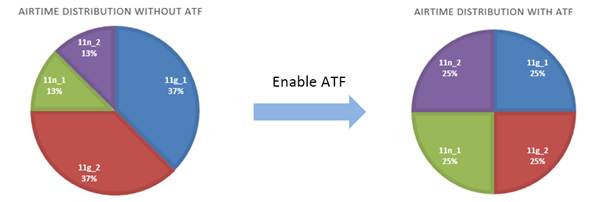

4.0-F_normal_20211214092556n.png)
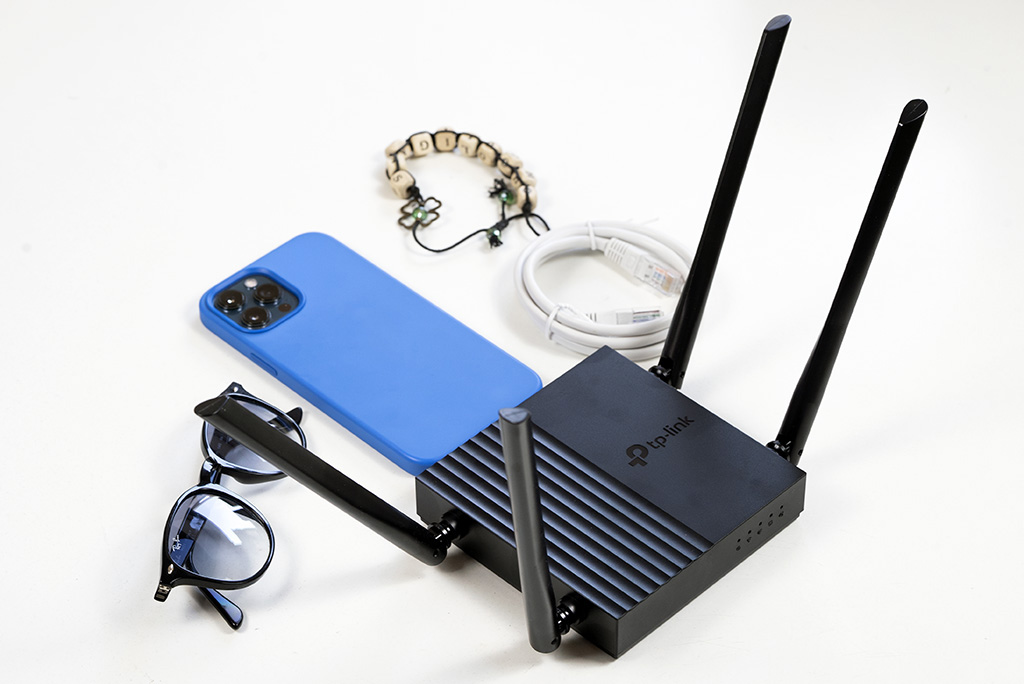

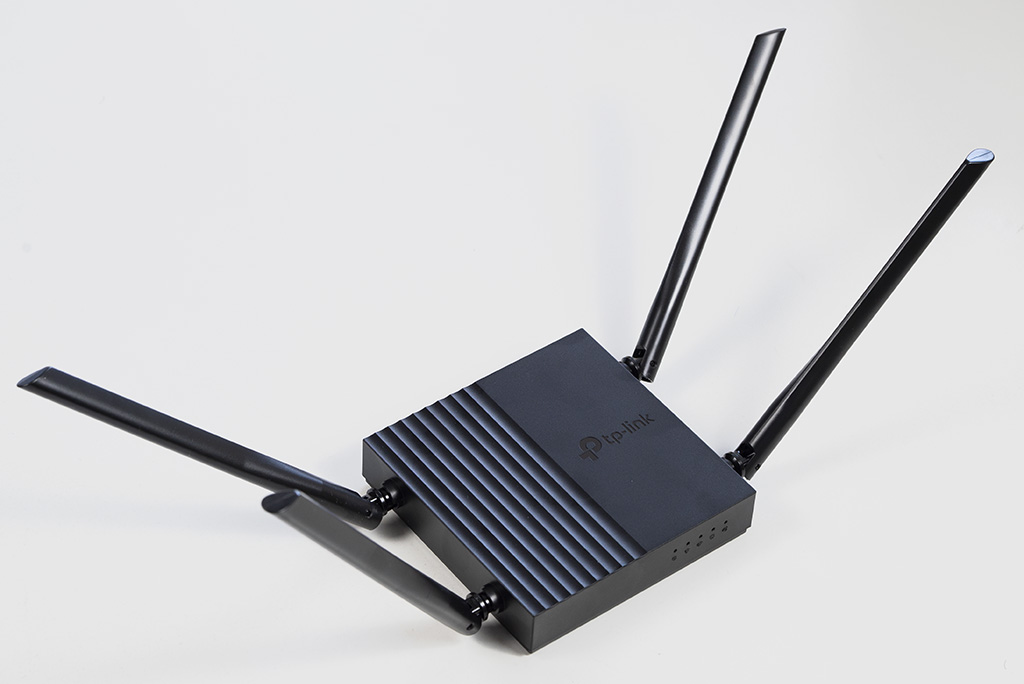

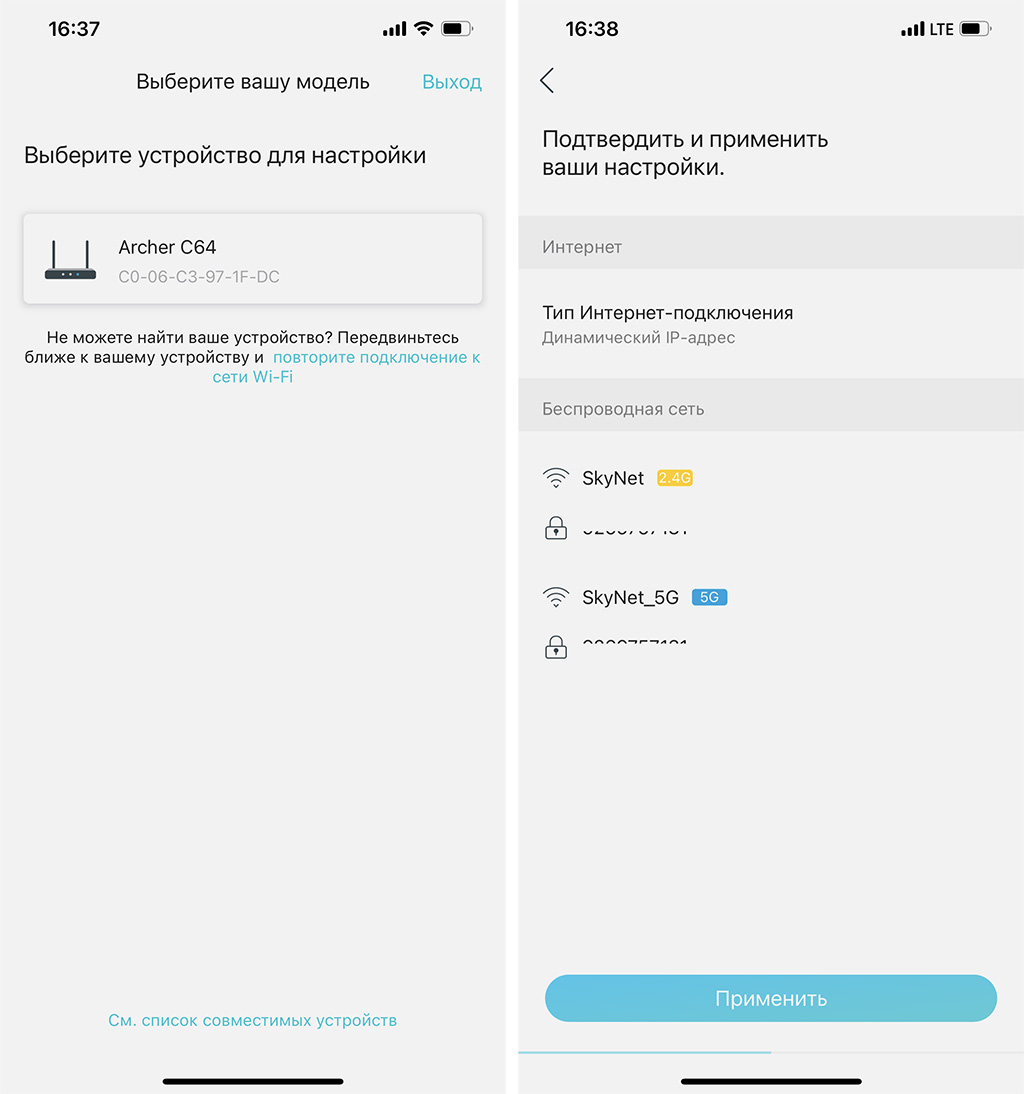
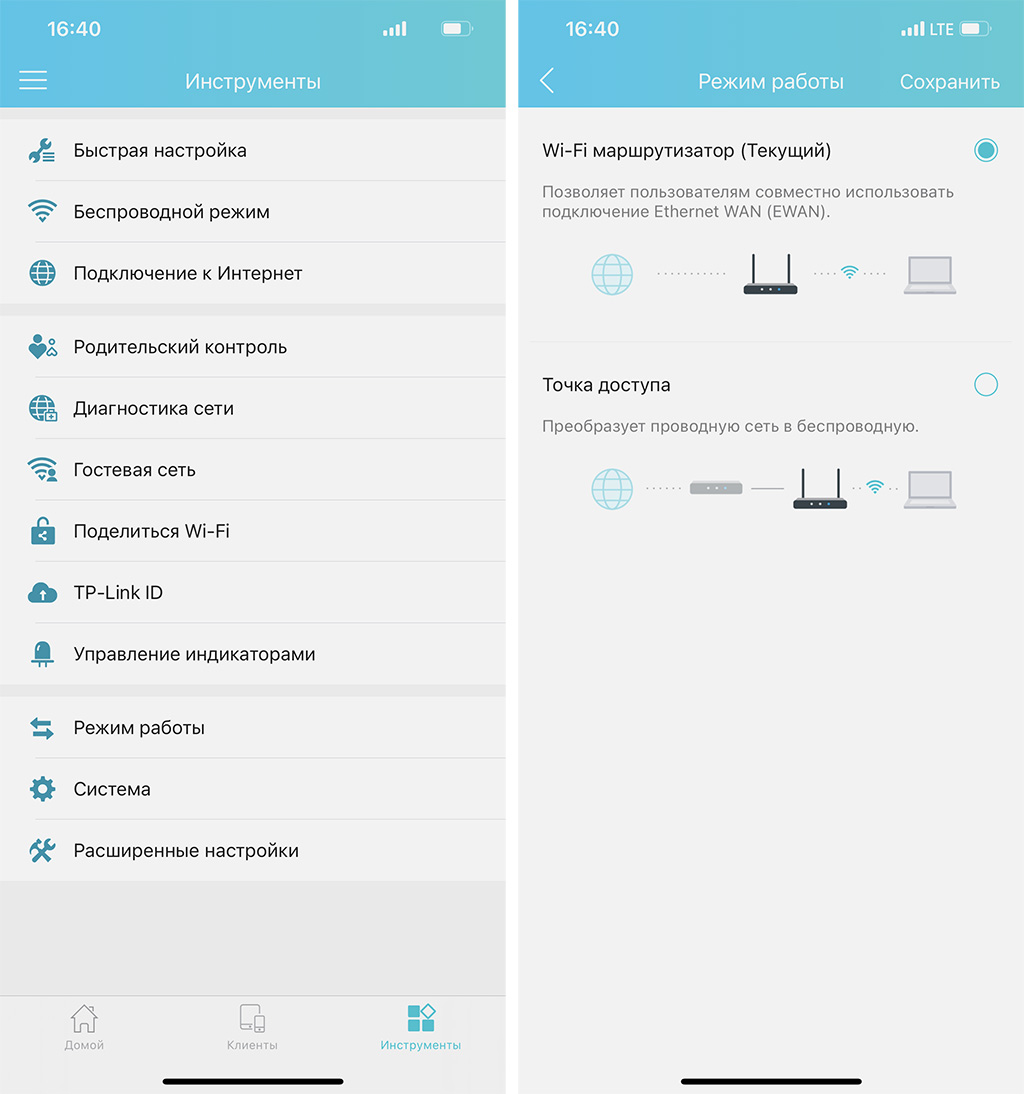
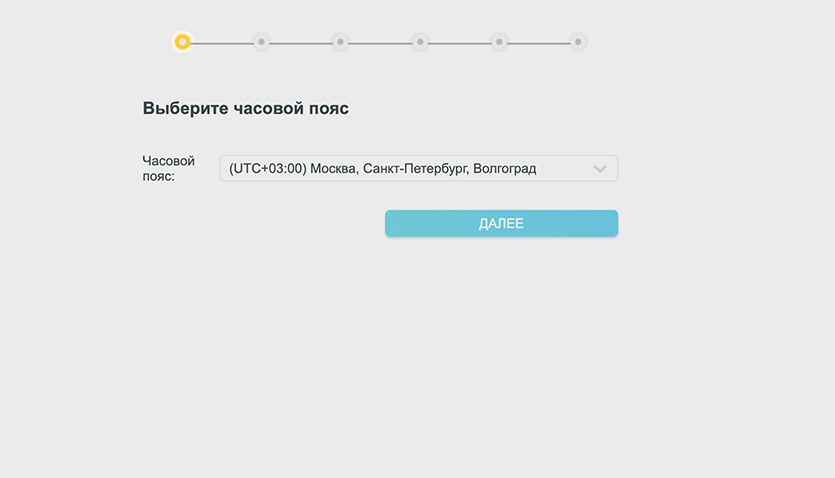



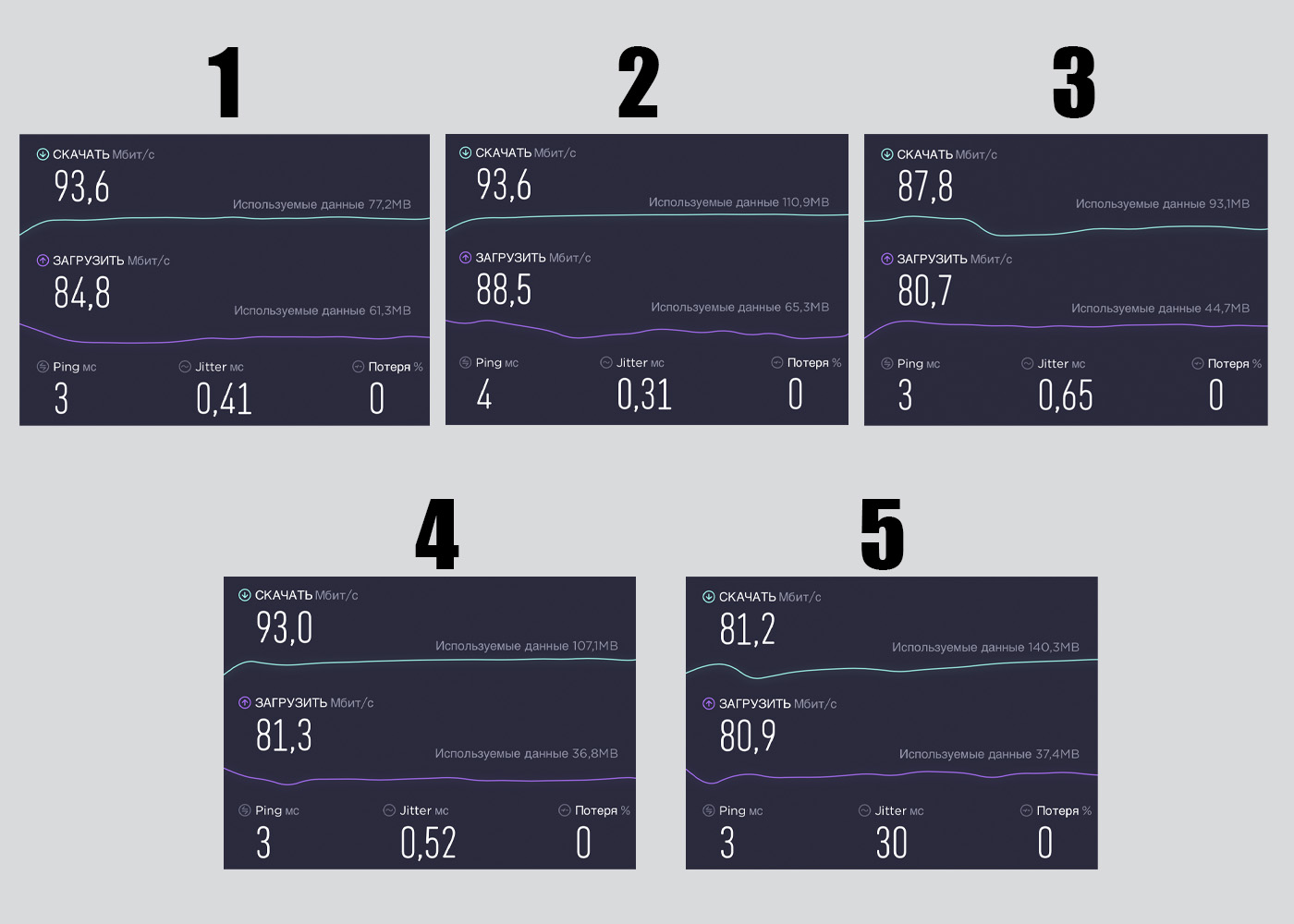






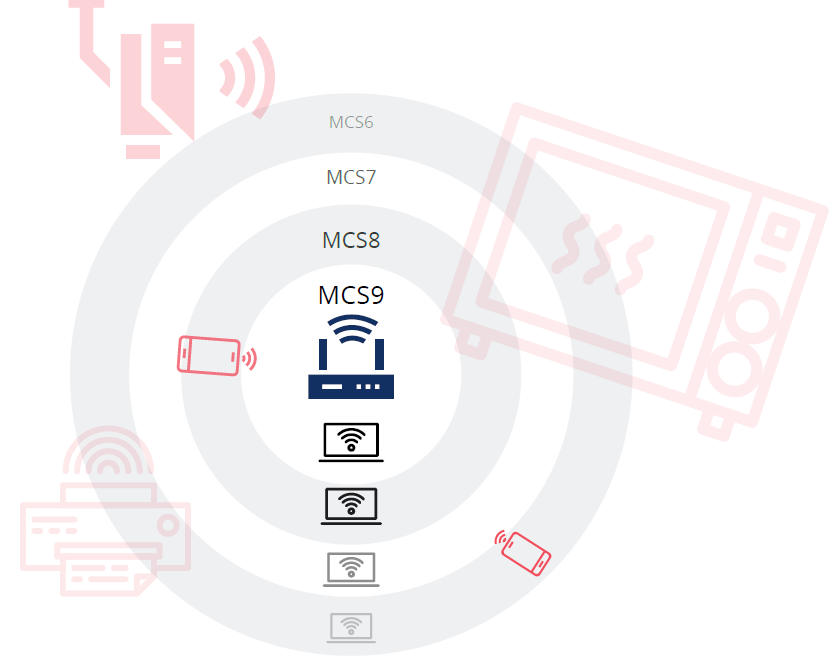





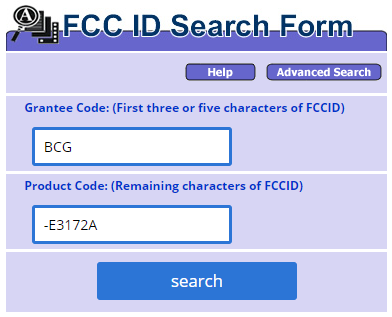
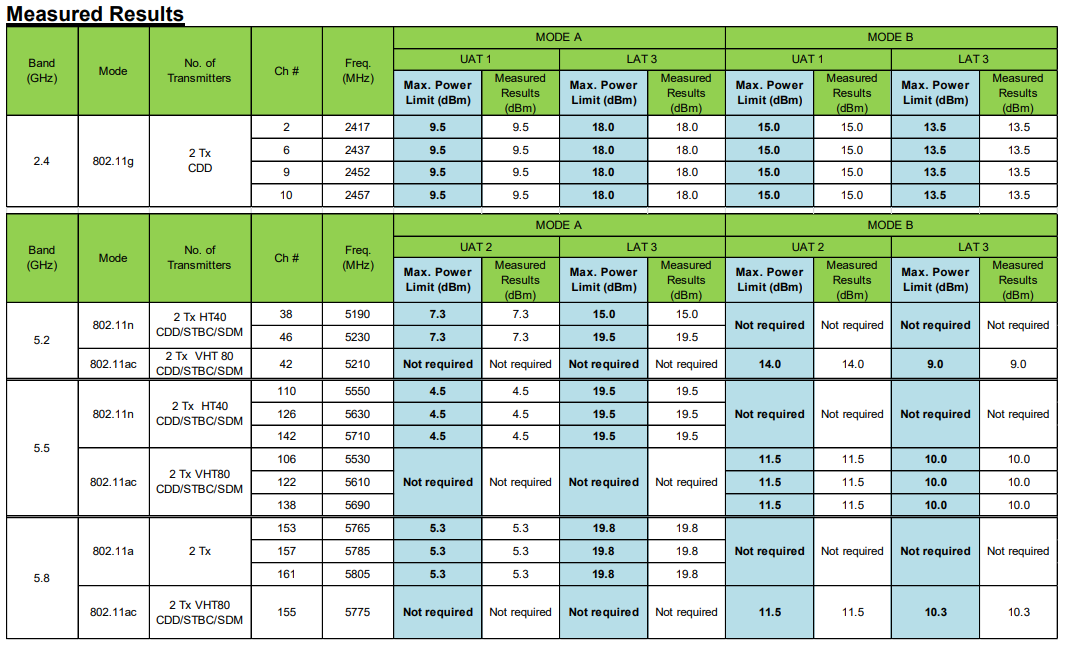

1_normal_1617103429900z.png)
4.0-F_normal_1593323233431q.png)














